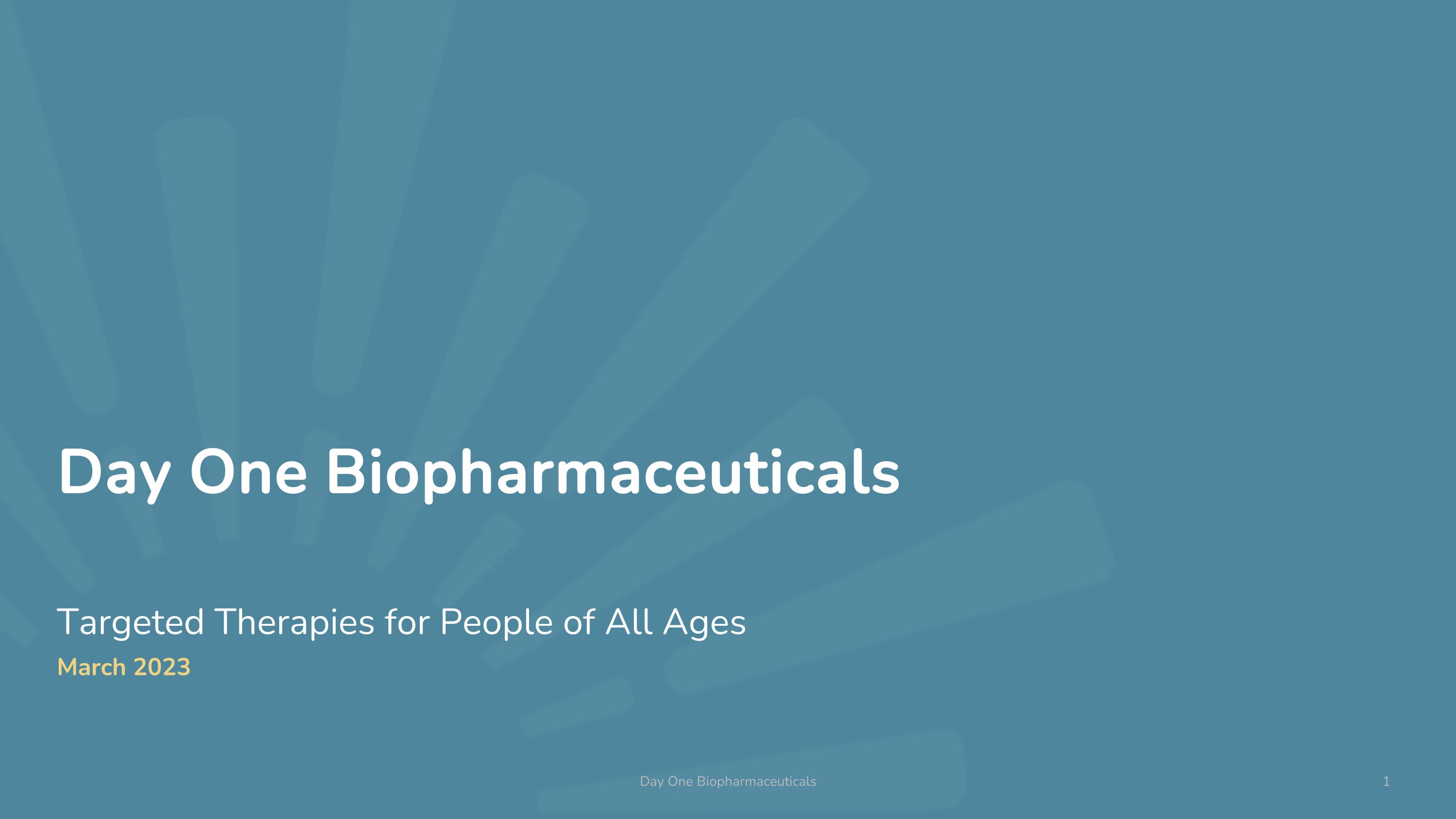
Day One Biopharmaceuticals Day One Biopharmaceuticals Targeted Therapies for People of All Ages March 2023
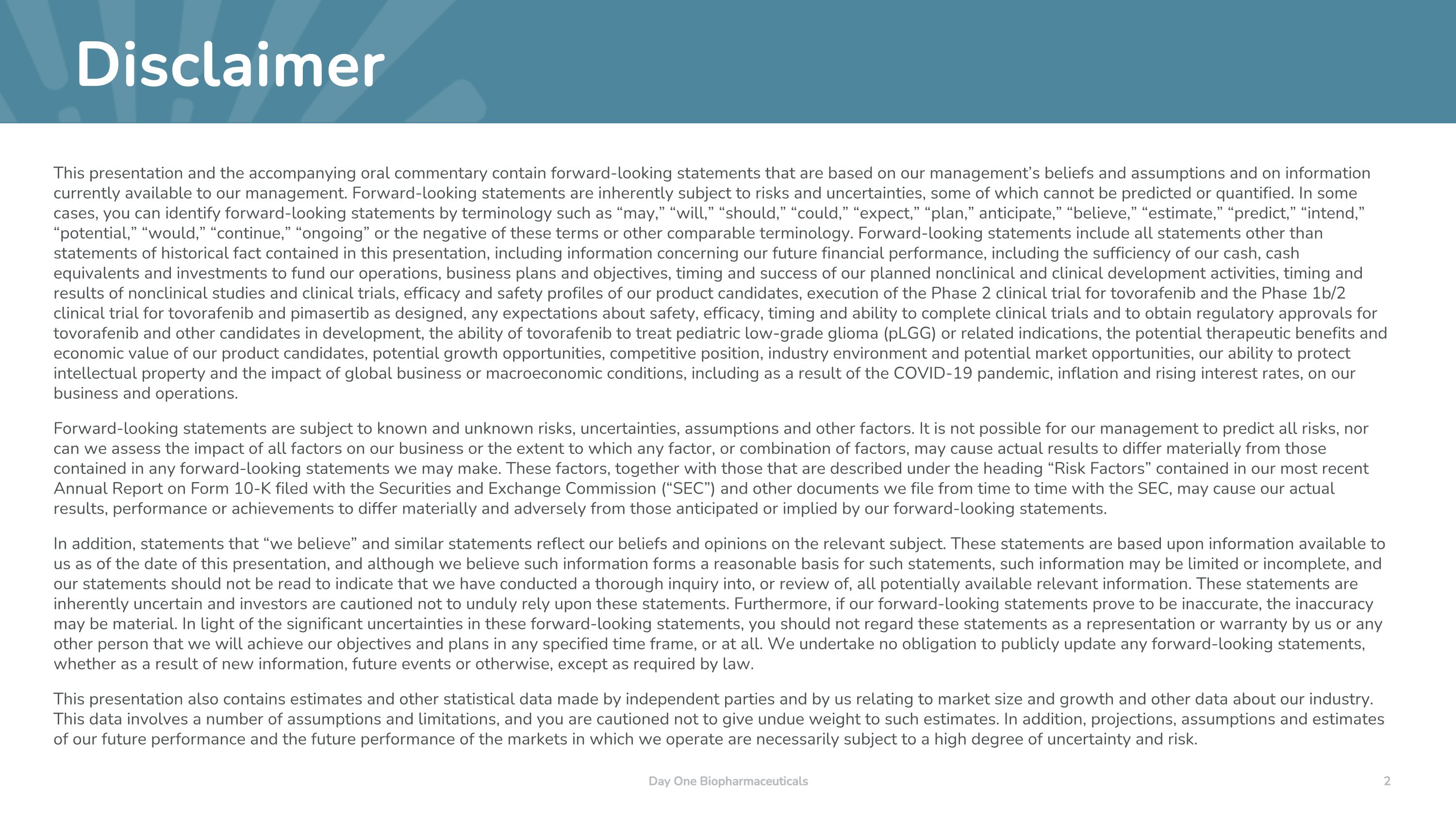
Disclaimer This presentation and the accompanying oral commentary contain forward-looking statements that are based on our management’s beliefs and assumptions and on information currently available to our management. Forward-looking statements are inherently subject to risks and uncertainties, some of which cannot be predicted or quantified. In some cases, you can identify forward-looking statements by terminology such as “may,” “will,” “should,” “could,” “expect,” “plan,” anticipate,” “believe,” “estimate,” “predict,” “intend,” “potential,” “would,” “continue,” “ongoing” or the negative of these terms or other comparable terminology. Forward-looking statements include all statements other than statements of historical fact contained in this presentation, including information concerning our future financial performance, including the sufficiency of our cash, cash equivalents and investments to fund our operations, business plans and objectives, timing and success of our planned nonclinical and clinical development activities, timing and results of nonclinical studies and clinical trials, efficacy and safety profiles of our product candidates, execution of the Phase 2 clinical trial for tovorafenib and the Phase 1b/2 clinical trial for tovorafenib and pimasertib as designed, any expectations about safety, efficacy, timing and ability to complete clinical trials and to obtain regulatory approvals for tovorafenib and other candidates in development, the ability of tovorafenib to treat pediatric low-grade glioma (pLGG) or related indications, the potential therapeutic benefits and economic value of our product candidates, potential growth opportunities, competitive position, industry environment and potential market opportunities, our ability to protect intellectual property and the impact of global business or macroeconomic conditions, including as a result of the COVID-19 pandemic, inflation and rising interest rates, on our business and operations. Forward-looking statements are subject to known and unknown risks, uncertainties, assumptions and other factors. It is not possible for our management to predict all risks, nor can we assess the impact of all factors on our business or the extent to which any factor, or combination of factors, may cause actual results to differ materially from those contained in any forward-looking statements we may make. These factors, together with those that are described under the heading “Risk Factors” contained in our most recent Annual Report on Form 10-K filed with the Securities and Exchange Commission (“SEC”) and other documents we file from time to time with the SEC, may cause our actual results, performance or achievements to differ materially and adversely from those anticipated or implied by our forward-looking statements. In addition, statements that “we believe” and similar statements reflect our beliefs and opinions on the relevant subject. These statements are based upon information available to us as of the date of this presentation, and although we believe such information forms a reasonable basis for such statements, such information may be limited or incomplete, and our statements should not be read to indicate that we have conducted a thorough inquiry into, or review of, all potentially available relevant information. These statements are inherently uncertain and investors are cautioned not to unduly rely upon these statements. Furthermore, if our forward-looking statements prove to be inaccurate, the inaccuracy may be material. In light of the significant uncertainties in these forward-looking statements, you should not regard these statements as a representation or warranty by us or any other person that we will achieve our objectives and plans in any specified time frame, or at all. We undertake no obligation to publicly update any forward-looking statements, whether as a result of new information, future events or otherwise, except as required by law. This presentation also contains estimates and other statistical data made by independent parties and by us relating to market size and growth and other data about our industry. This data involves a number of assumptions and limitations, and you are cautioned not to give undue weight to such estimates. In addition, projections, assumptions and estimates of our future performance and the future performance of the markets in which we operate are necessarily subject to a high degree of uncertainty and risk. Day One Biopharmaceuticals
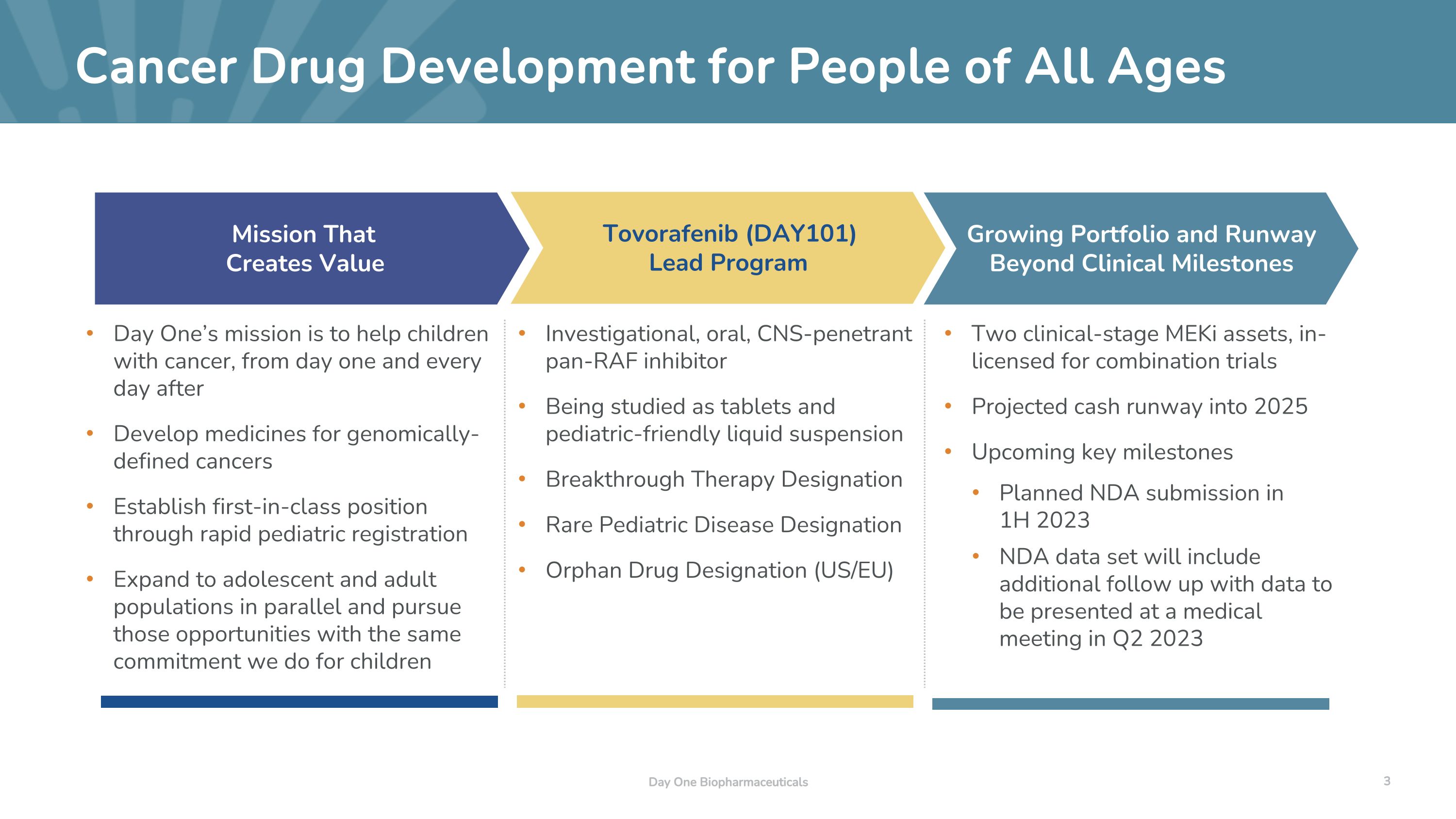
Cancer Drug Development for People of All Ages Growing Portfolio and Runway Beyond Clinical Milestones Tovorafenib (DAY101) Lead Program Mission That �Creates Value Day One’s mission is to help children with cancer, from day one and every day after Develop medicines for genomically-defined cancers Establish first-in-class position through rapid pediatric registration Expand to adolescent and adult populations in parallel and pursue those opportunities with the same commitment we do for children Investigational, oral, CNS-penetrant pan-RAF inhibitor Being studied as tablets and pediatric-friendly liquid suspension Breakthrough Therapy Designation Rare Pediatric Disease Designation Orphan Drug Designation (US/EU) Two clinical-stage MEKi assets, in-licensed for combination trials Projected cash runway into 2025 Upcoming key milestones Planned NDA submission in 1H 2023 NDA data set will include additional follow up with data to be presented at a medical meeting in Q2 2023 Day One Biopharmaceuticals
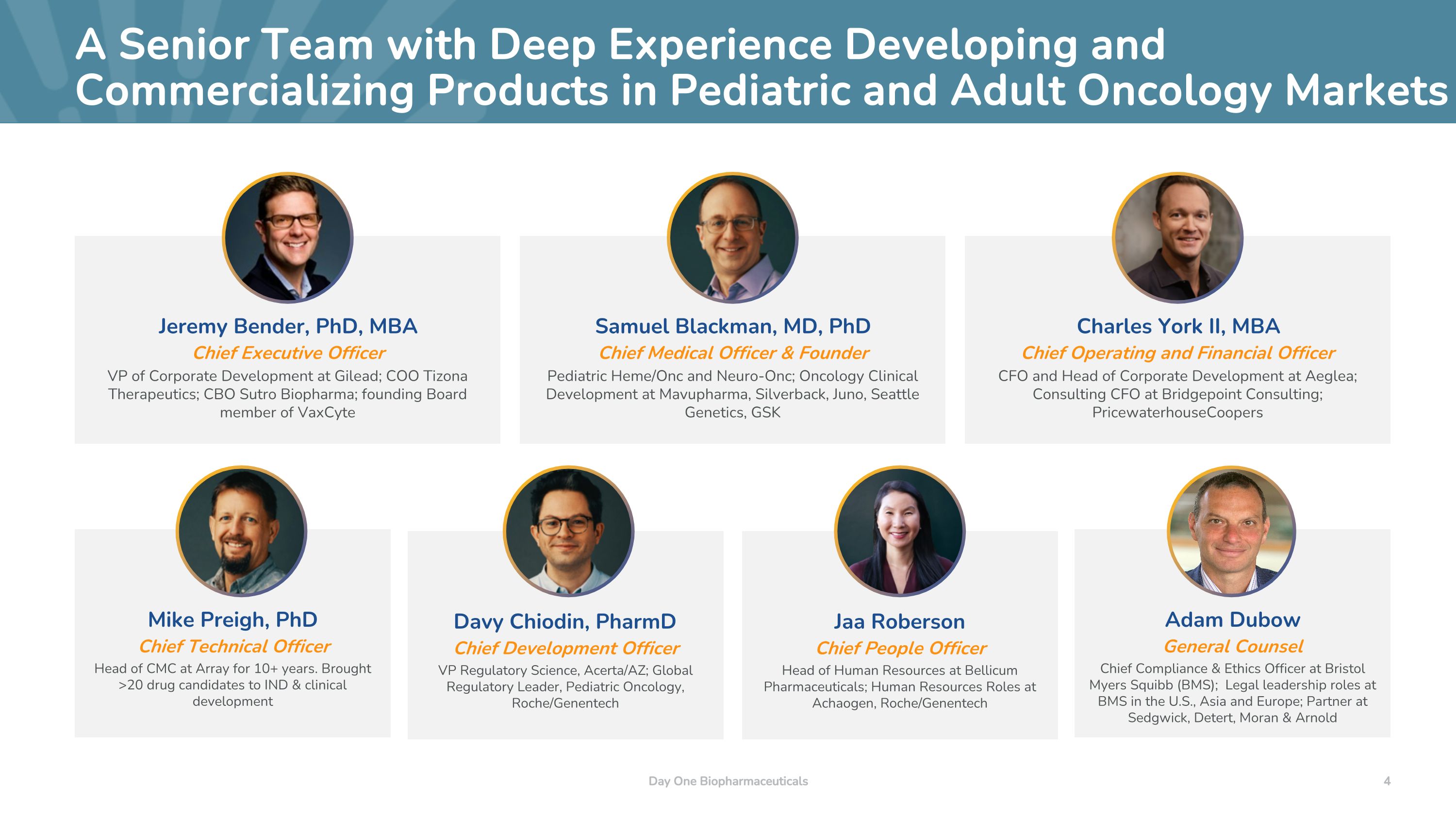
Jaa Roberson Chief People Officer Head of Human Resources at Bellicum Pharmaceuticals; Human Resources Roles at Achaogen, Roche/Genentech Davy Chiodin, PharmD Chief Development Officer VP Regulatory Science, Acerta/AZ; Global Regulatory Leader, Pediatric Oncology, Roche/Genentech A Senior Team with Deep Experience Developing and Commercializing Products in Pediatric and Adult Oncology Markets Samuel Blackman, MD, PhD Chief Medical Officer & Founder Pediatric Heme/Onc and Neuro-Onc; Oncology Clinical Development at Mavupharma, Silverback, Juno, Seattle Genetics, GSK Jeremy Bender, PhD, MBA Chief Executive Officer VP of Corporate Development at Gilead; COO Tizona Therapeutics; CBO Sutro Biopharma; founding Board member of VaxCyte Charles York II, MBA Chief Operating and Financial Officer CFO and Head of Corporate Development at Aeglea; Consulting CFO at Bridgepoint Consulting; PricewaterhouseCoopers Day One Biopharmaceuticals Mike Preigh, PhD Chief Technical Officer Head of CMC at Array for 10+ years. Brought >20 drug candidates to IND & clinical development Adam Dubow General Counsel Chief Compliance & Ethics Officer at Bristol Myers Squibb (BMS); Legal leadership roles at BMS in the U.S., Asia and Europe; Partner at Sedgwick, Detert, Moran & Arnold
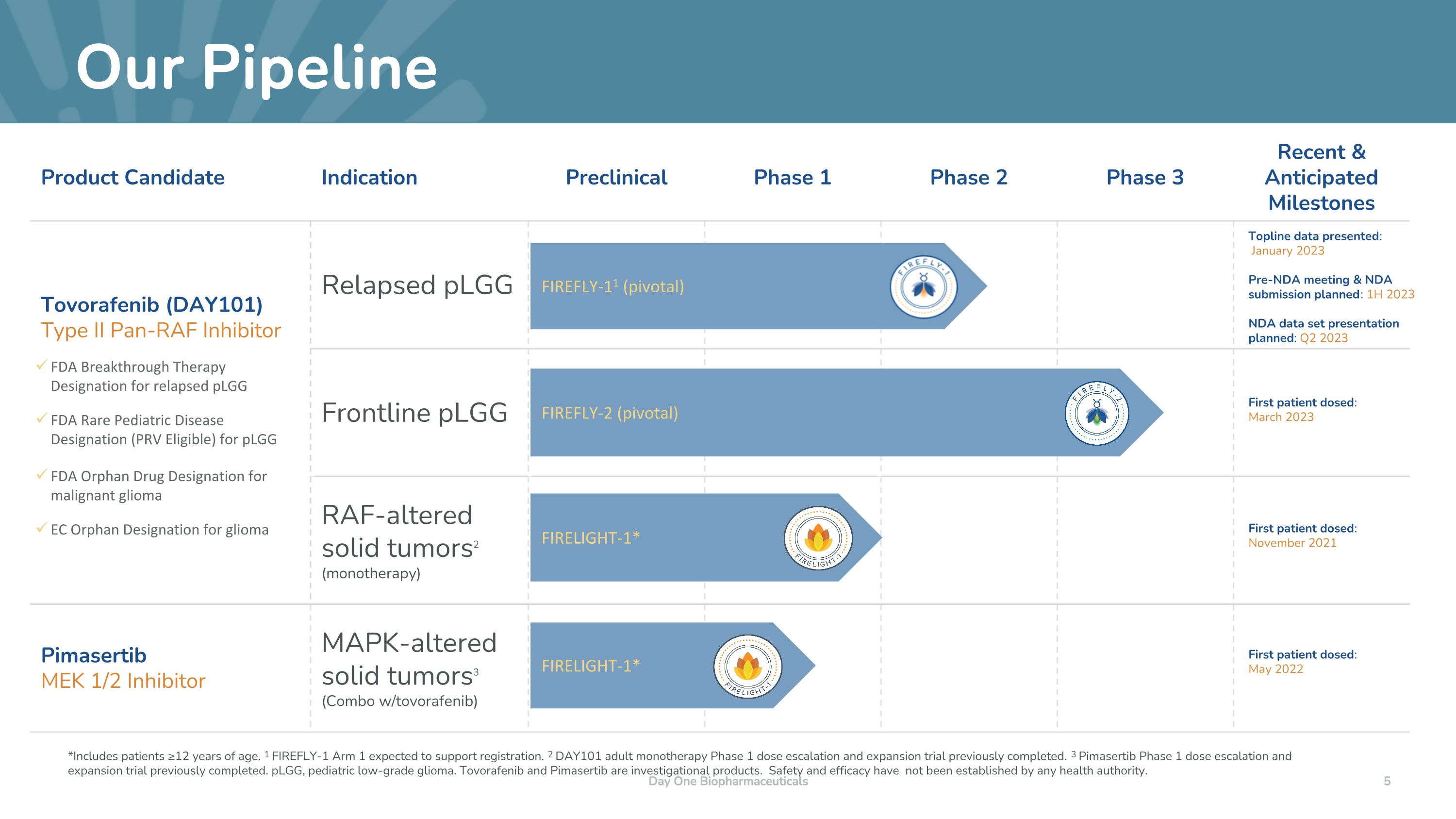
Product Candidate Indication Preclinical Phase 1 Phase 2 Phase 3 Recent & Anticipated Milestones Tovorafenib (DAY101) Type II Pan-RAF Inhibitor Relapsed pLGG Frontline pLGG RAF-altered solid tumors2 (monotherapy) Pimasertib MEK 1/2 Inhibitor MAPK-altered solid tumors3 (Combo w/tovorafenib) Our Pipeline *Includes patients ≥12 years of age. 1 FIREFLY-1 Arm 1 expected to support registration. 2 DAY101 adult monotherapy Phase 1 dose escalation and expansion trial previously completed. 3 Pimasertib Phase 1 dose escalation and expansion trial previously completed. pLGG, pediatric low-grade glioma. Tovorafenib and Pimasertib are investigational products. Safety and efficacy have not been established by any health authority. Day One Biopharmaceuticals FDA Breakthrough Therapy Designation for relapsed pLGG FDA Orphan Drug Designation for malignant glioma EC Orphan Designation for glioma FDA Rare Pediatric Disease Designation (PRV Eligible) for pLGG FIREFLY-11 (pivotal) FIREFLY-2 (pivotal) FIRELIGHT-1* FIRELIGHT-1* First patient dosed: March 2023 First patient dosed: November 2021 First patient dosed: May 2022 Topline data presented: January 2023 Pre-NDA meeting & NDA submission planned: 1H 2023 NDA data set presentation planned: Q2 2023
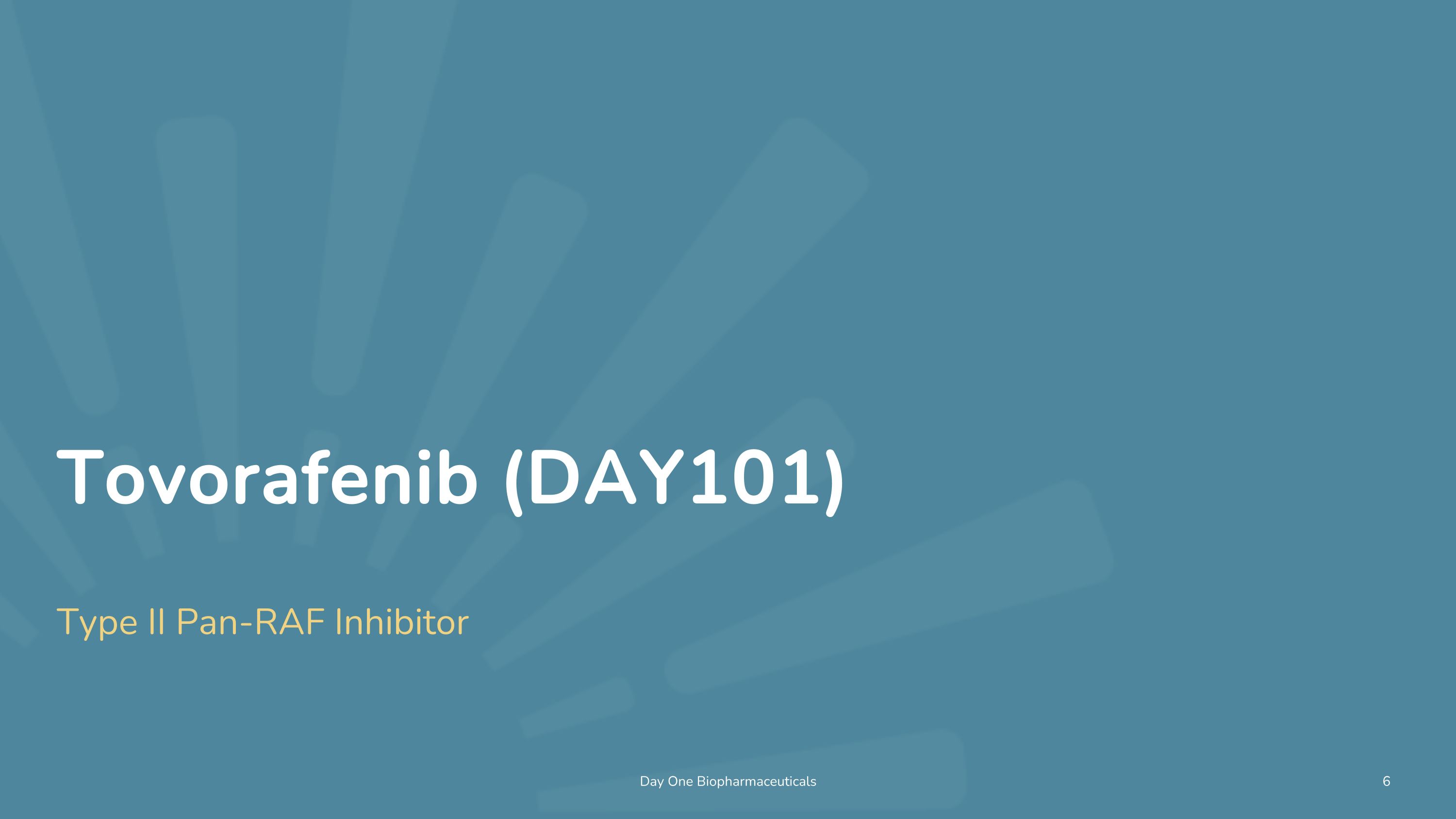
Day One Biopharmaceuticals Tovorafenib (DAY101) Type II Pan-RAF Inhibitor
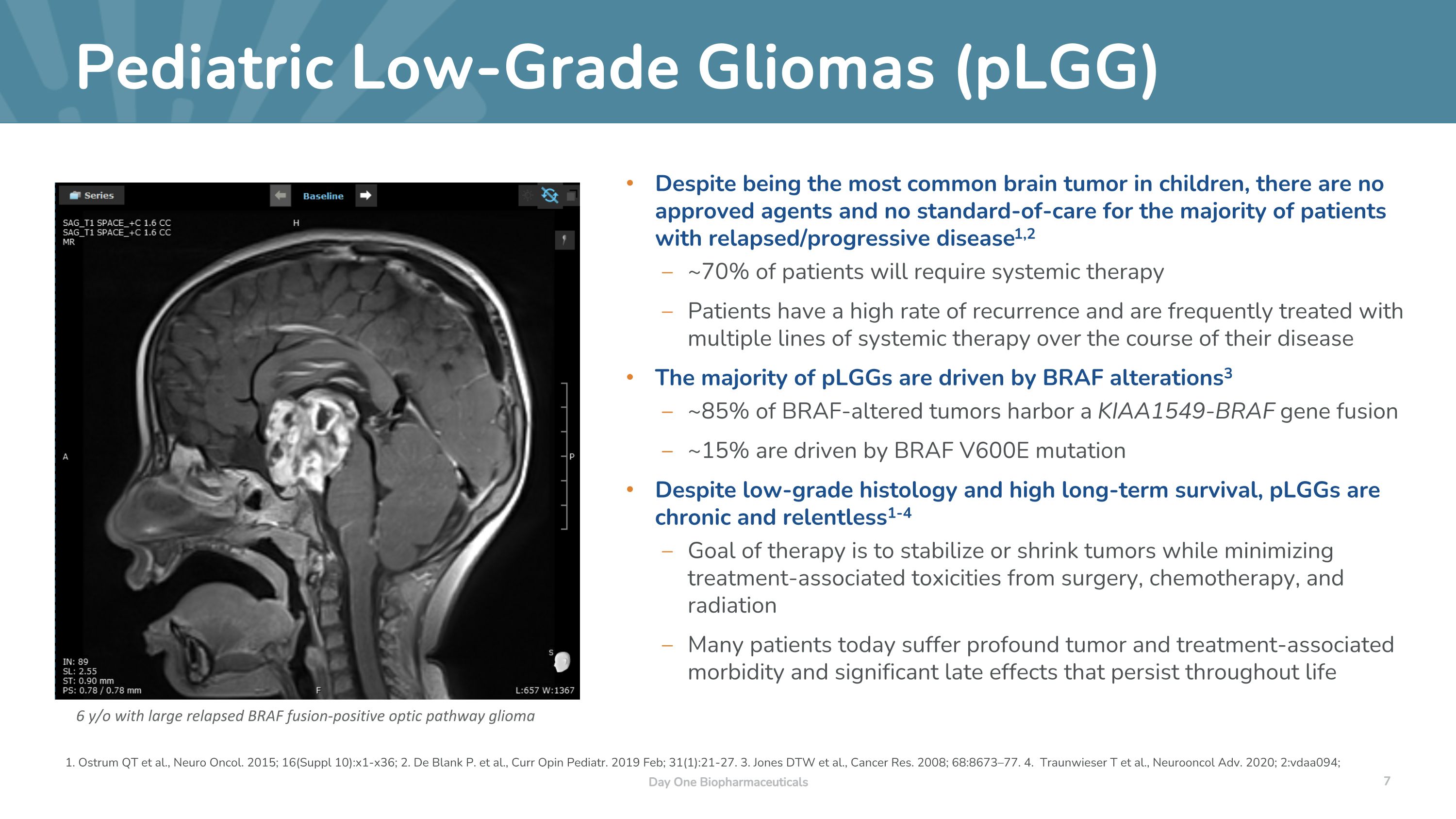
Pediatric Low-Grade Gliomas (pLGG) Day One Biopharmaceuticals Despite being the most common brain tumor in children, there are no approved agents and no standard-of-care for the majority of patients with relapsed/progressive disease1,2 ~70% of patients will require systemic therapy Patients have a high rate of recurrence and are frequently treated with multiple lines of systemic therapy over the course of their disease The majority of pLGGs are driven by BRAF alterations3 ~85% of BRAF-altered tumors harbor a KIAA1549-BRAF gene fusion ~15% are driven by BRAF V600E mutation Despite low-grade histology and high long-term survival, pLGGs are chronic and relentless1-4 Goal of therapy is to stabilize or shrink tumors while minimizing treatment-associated toxicities from surgery, chemotherapy, and radiation Many patients today suffer profound tumor and treatment-associated morbidity and significant late effects that persist throughout life 6 y/o with large relapsed BRAF fusion-positive optic pathway glioma 1. Ostrum QT et al., Neuro Oncol. 2015; 16(Suppl 10):x1-x36; 2. De Blank P. et al., Curr Opin Pediatr. 2019 Feb; 31(1):21-27. 3. Jones DTW et al., Cancer Res. 2008; 68:8673–77. 4. Traunwieser T et al., Neurooncol Adv. 2020; 2:vdaa094;
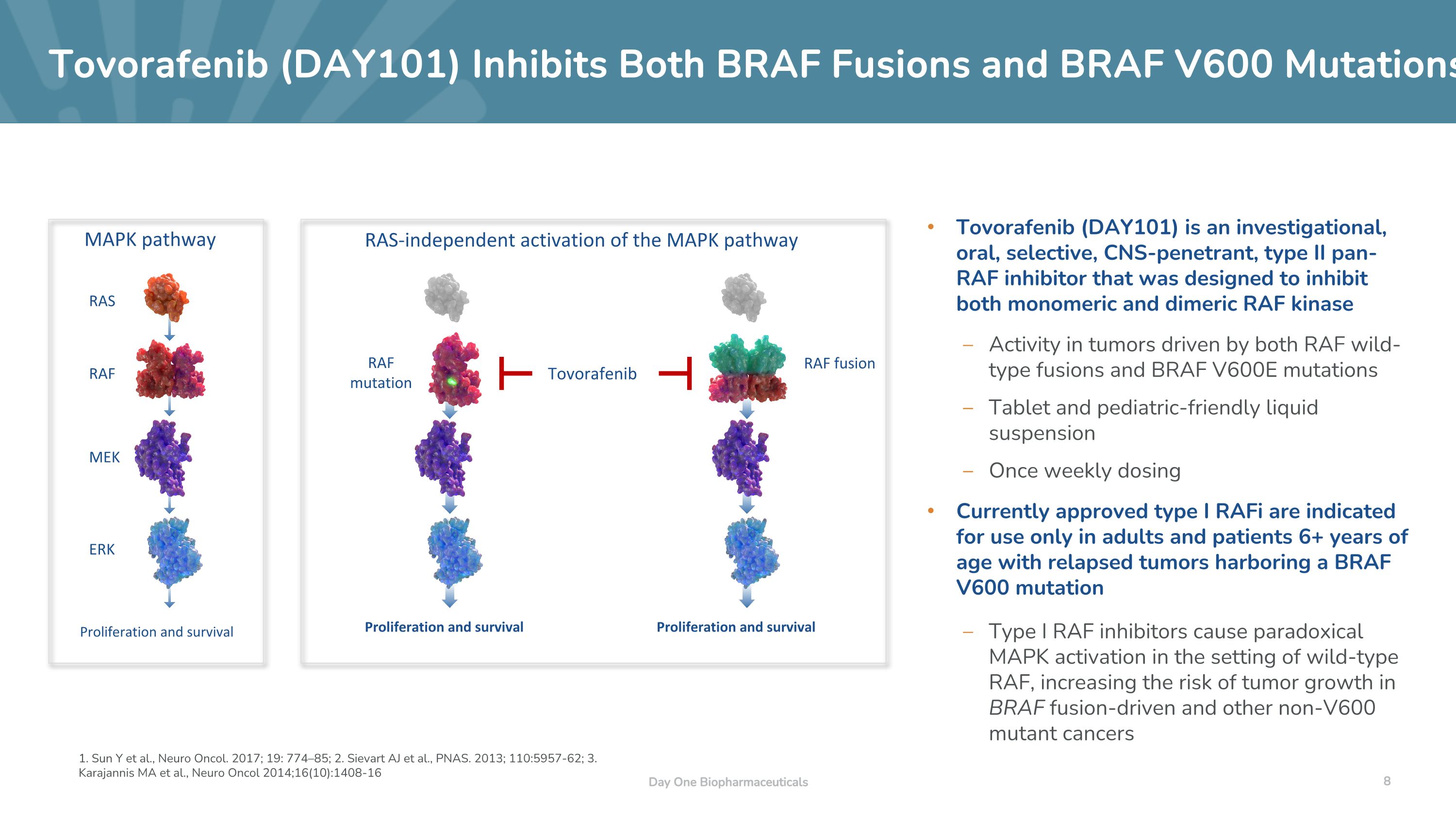
Tovorafenib (DAY101) Inhibits Both BRAF Fusions and BRAF V600 Mutations Day One Biopharmaceuticals Tovorafenib (DAY101) is an investigational, oral, selective, CNS-penetrant, type II pan-RAF inhibitor that was designed to inhibit both monomeric and dimeric RAF kinase Activity in tumors driven by both RAF wild-type fusions and BRAF V600E mutations Tablet and pediatric-friendly liquid suspension Once weekly dosing Currently approved type I RAFi are indicated for use only in adults and patients 6+ years of age with relapsed tumors harboring a BRAF V600 mutation Type I RAF inhibitors cause paradoxical MAPK activation in the setting of wild-type RAF, increasing the risk of tumor growth in BRAF fusion-driven and other non-V600 mutant cancers RAS-independent activation of the MAPK pathway MAPK pathway RAS RAF MEK ERK Proliferation and survival RAF mutation RAF fusion Proliferation and survival Proliferation and survival Tovorafenib 1. Sun Y et al., Neuro Oncol. 2017; 19: 774–85; 2. Sievart AJ et al., PNAS. 2013; 110:5957-62; 3. Karajannis MA et al., Neuro Oncol 2014;16(10):1408-16
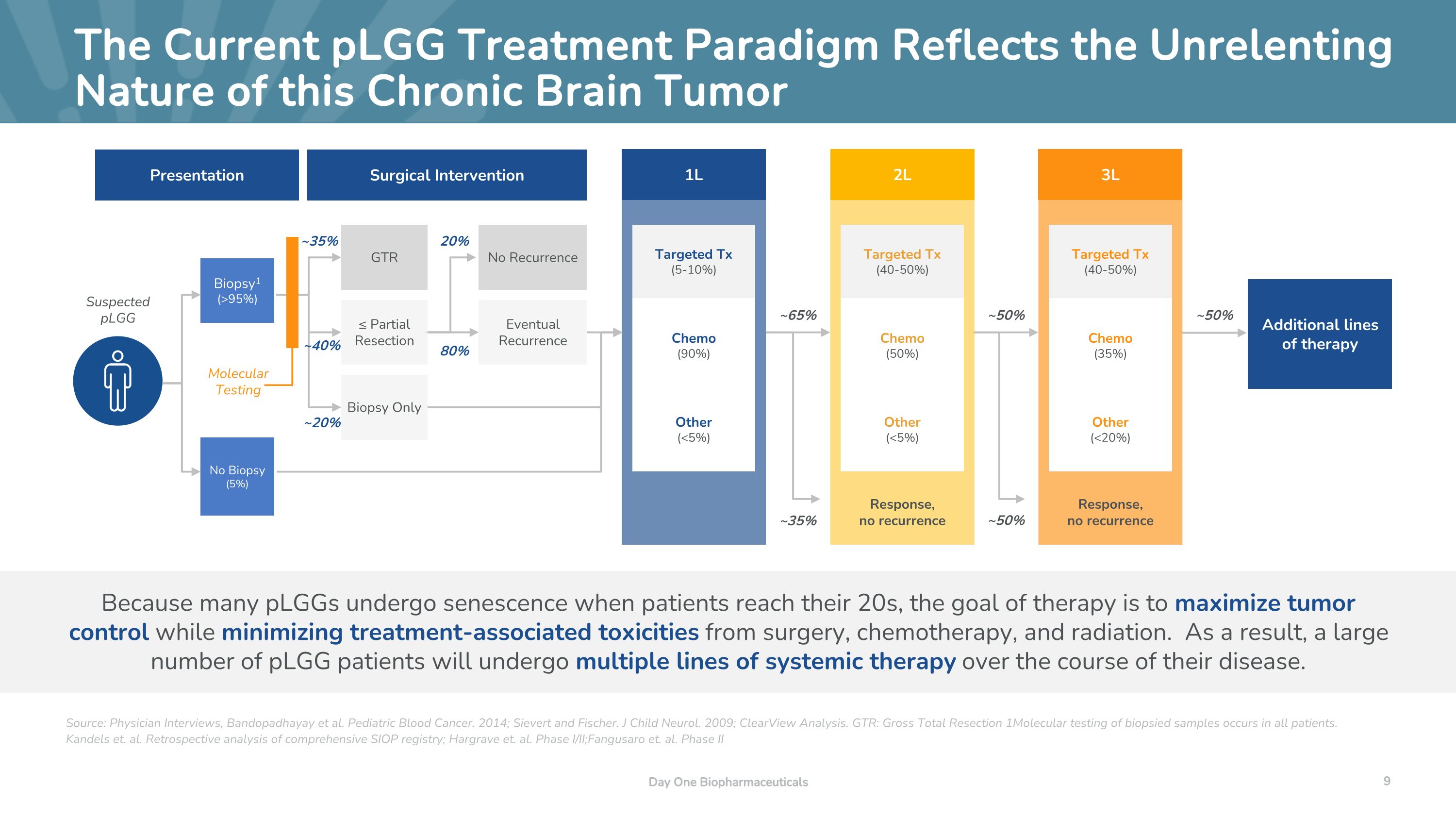
The Current pLGG Treatment Paradigm Reflects the Unrelenting Nature of this Chronic Brain Tumor Day One Biopharmaceuticals Source: Physician Interviews, Bandopadhayay et al. Pediatric Blood Cancer. 2014; Sievert and Fischer. J Child Neurol. 2009; ClearView Analysis. GTR: Gross Total Resection 1Molecular testing of biopsied samples occurs in all patients. Kandels et. al. Retrospective analysis of comprehensive SIOP registry; Hargrave et. al. Phase I/II;Fangusaro et. al. Phase II Because many pLGGs undergo senescence when patients reach their 20s, the goal of therapy is to maximize tumor control while minimizing treatment-associated toxicities from surgery, chemotherapy, and radiation. As a result, a large number of pLGG patients will undergo multiple lines of systemic therapy over the course of their disease. Surgical Intervention Suspected pLGG GTR No Recurrence Eventual Recurrence 80% 20% ~35% Presentation 1L ~35% 2L Response, �no recurrence 3L Chemo�(90%) Chemo�(50%) Chemo�(35%) Other�(<5%) Other�(<5%) Other�(<20%) Targeted Tx�(5-10%) Targeted Tx�(40-50%) Targeted Tx�(40-50%) Response, �no recurrence ~50% Biopsy Only ~40% ~20% Molecular Testing Biopsy1�(>95%) No Biopsy�(5%) ≤ Partial Resection ~65% ~50% ~50% Additional lines of therapy
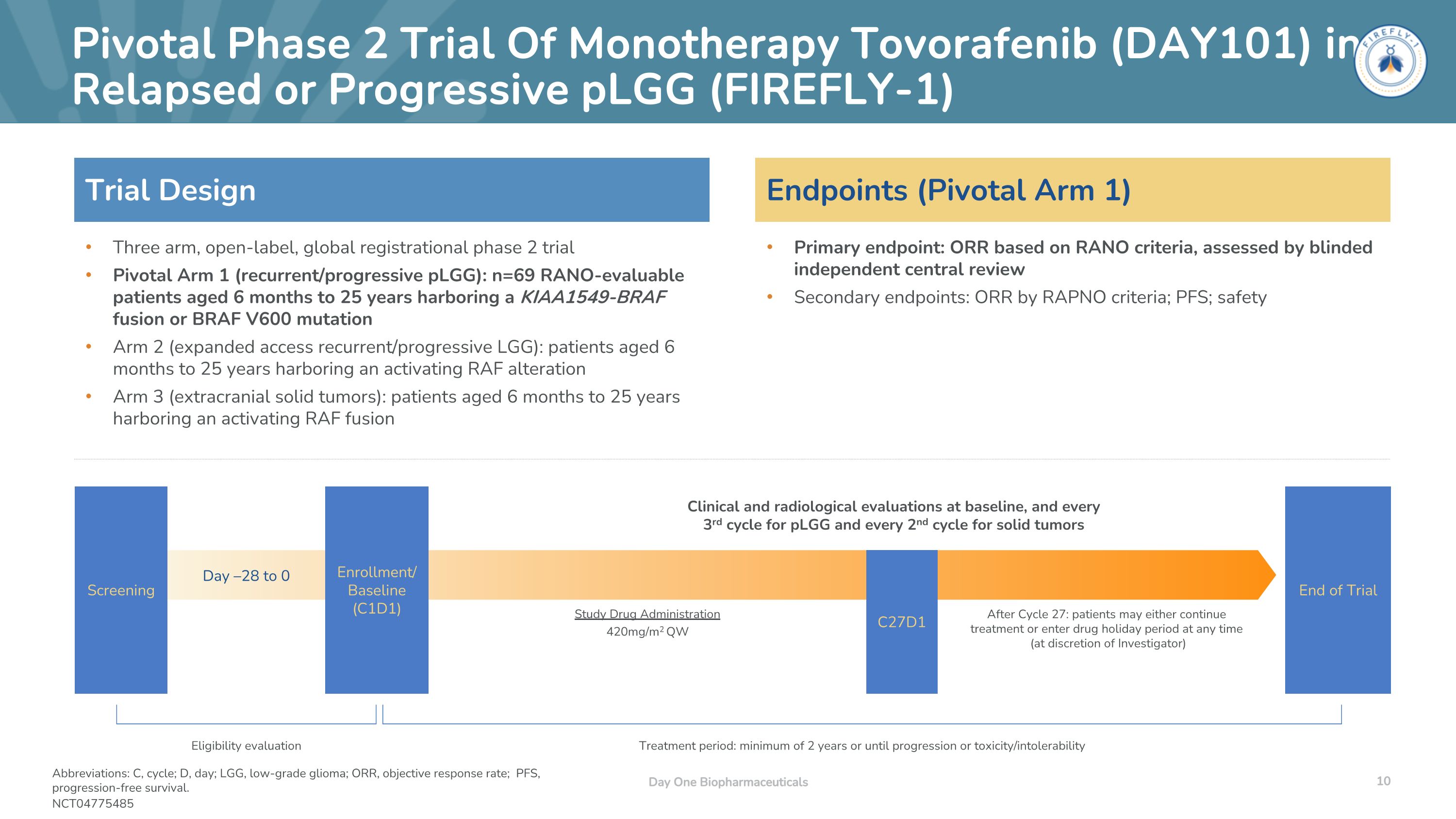
Pivotal Phase 2 Trial Of Monotherapy Tovorafenib (DAY101) in Relapsed or Progressive pLGG (FIREFLY-1) Day One Biopharmaceuticals Primary endpoint: ORR based on RANO criteria, assessed by blinded independent central review Secondary endpoints: ORR by RAPNO criteria; PFS; safety Three arm, open-label, global registrational phase 2 trial Pivotal Arm 1 (recurrent/progressive pLGG): n=69 RANO-evaluable patients aged 6 months to 25 years harboring a KIAA1549-BRAF fusion or BRAF V600 mutation Arm 2 (expanded access recurrent/progressive LGG): patients aged 6 months to 25 years harboring an activating RAF alteration Arm 3 (extracranial solid tumors): patients aged 6 months to 25 years harboring an activating RAF fusion Endpoints (Pivotal Arm 1) Trial Design Day –28 to 0 Study Drug Administration 420mg/m2 QW After Cycle 27: patients may either continue treatment or enter drug holiday period at any time (at discretion of Investigator) Screening C27D1 Enrollment/ Baseline (C1D1) End of Trial Clinical and radiological evaluations at baseline, and every 3rd cycle for pLGG and every 2nd cycle for solid tumors Eligibility evaluation Treatment period: minimum of 2 years or until progression or toxicity/intolerability Abbreviations: C, cycle; D, day; LGG, low-grade glioma; ORR, objective response rate; PFS, progression-free survival. NCT04775485
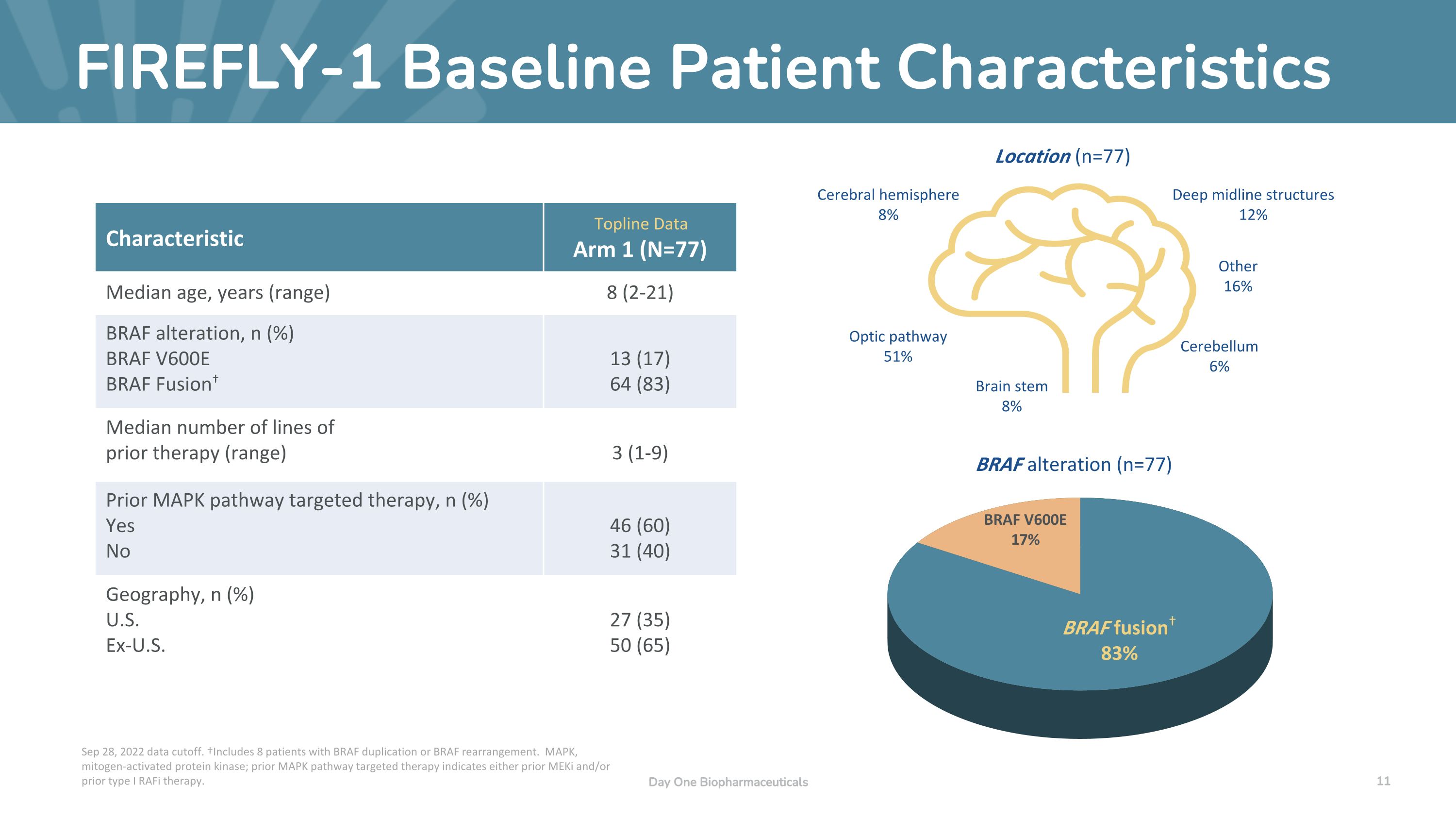
FIREFLY-1 Baseline Patient Characteristics Day One Biopharmaceuticals Characteristic Topline Data Arm 1 (N=77) Median age, years (range) 8 (2-21) BRAF alteration, n (%) BRAF V600E BRAF Fusion† 13 (17) 64 (83) Median number of lines of prior therapy (range) 3 (1-9) Prior MAPK pathway targeted therapy, n (%) Yes No 46 (60) 31 (40) Geography, n (%) U.S. Ex-U.S. 27 (35) 50 (65) BRAF alteration (n=77) Location (n=77) Optic pathway 51% BRAF V600E 17% BRAF fusion† 83% Cerebellum 6% Deep midline structures 12% Brain stem 8% Cerebral hemisphere 8% Other 16% Sep 28, 2022 data cutoff. †Includes 8 patients with BRAF duplication or BRAF rearrangement. MAPK, mitogen-activated protein kinase; prior MAPK pathway targeted therapy indicates either prior MEKi and/or prior type I RAFi therapy.
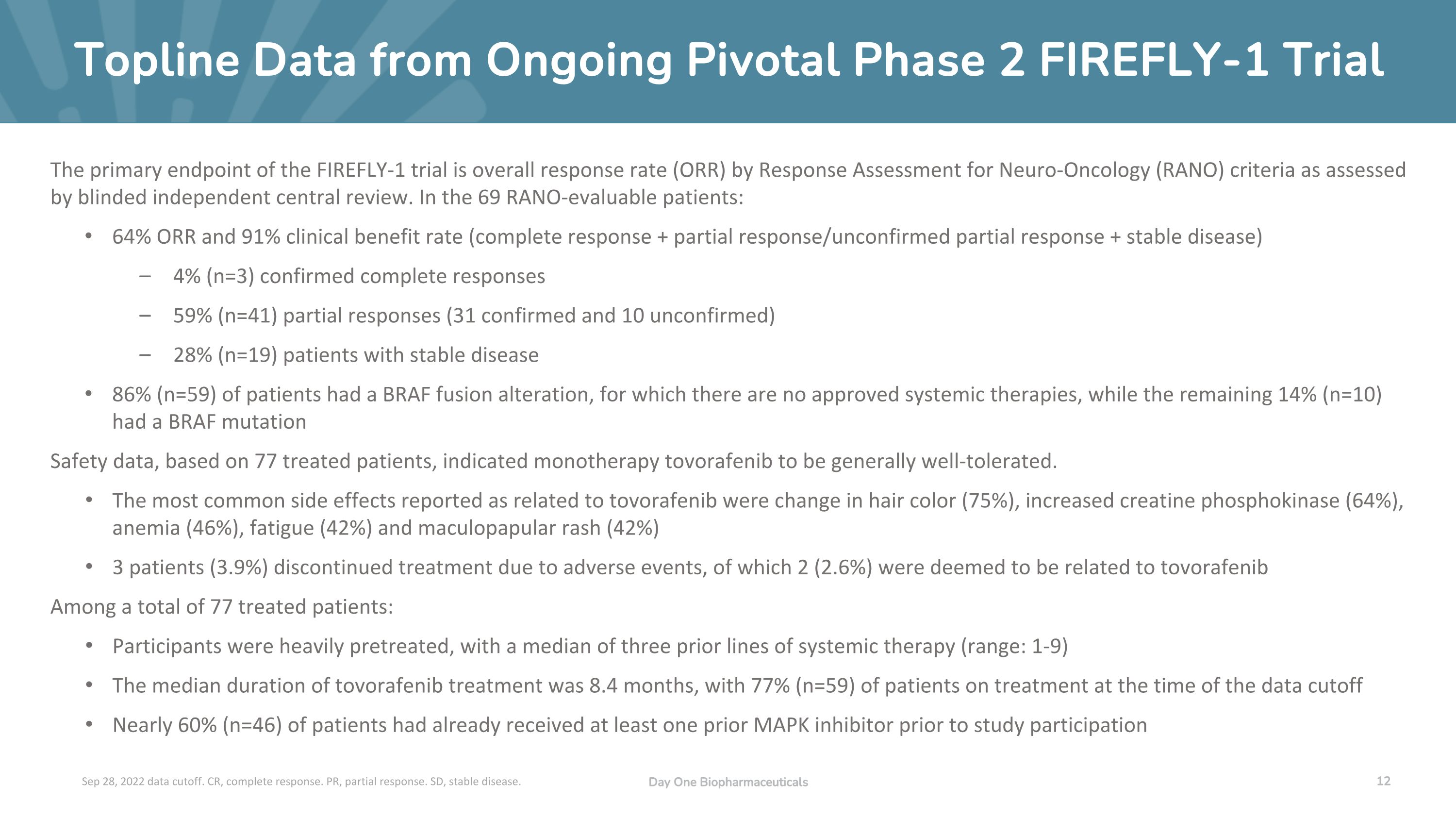
Topline Data from Ongoing Pivotal Phase 2 FIREFLY-1 Trial Day One Biopharmaceuticals Sep 28, 2022 data cutoff. CR, complete response. PR, partial response. SD, stable disease. The primary endpoint of the FIREFLY-1 trial is overall response rate (ORR) by Response Assessment for Neuro-Oncology (RANO) criteria as assessed by blinded independent central review. In the 69 RANO-evaluable patients: 64% ORR and 91% clinical benefit rate (complete response + partial response/unconfirmed partial response + stable disease) 4% (n=3) confirmed complete responses 59% (n=41) partial responses (31 confirmed and 10 unconfirmed) 28% (n=19) patients with stable disease 86% (n=59) of patients had a BRAF fusion alteration, for which there are no approved systemic therapies, while the remaining 14% (n=10) had a BRAF mutation Safety data, based on 77 treated patients, indicated monotherapy tovorafenib to be generally well-tolerated. The most common side effects reported as related to tovorafenib were change in hair color (75%), increased creatine phosphokinase (64%), anemia (46%), fatigue (42%) and maculopapular rash (42%) 3 patients (3.9%) discontinued treatment due to adverse events, of which 2 (2.6%) were deemed to be related to tovorafenib Among a total of 77 treated patients: Participants were heavily pretreated, with a median of three prior lines of systemic therapy (range: 1-9) The median duration of tovorafenib treatment was 8.4 months, with 77% (n=59) of patients on treatment at the time of the data cutoff Nearly 60% (n=46) of patients had already received at least one prior MAPK inhibitor prior to study participation

~26,000 Estimated Prevalence Incidence and Prevalence of BRAF-altered pLGG in the U.S. Day One Biopharmaceuticals 1. US Census; 2 CBTRUS, Qaddoumi et al 2009, Schreck et al 2019, ClearView Analysis; 3 SEER US complete prevalence counts of patients aged under 25 with Brain and Other Nervous Systems tumors as of January 1, 2017. Estimated annual incidence and estimated prevalence are Day One calculations based on publicly available data. 2020 Estimated Incidence Under 25 US Population1 ~105,000,000 Rate of CNS Tumors (0.00521%)2 ~5,500 Gliomas (63%)2 ~3,500 Low Grade (77%)2 ~2,600 Has Received Drug Tx (58%)2 ~1,500 BRAF Altered (70%)2 ~1,100 2017 Estimated SEER Prevalence Under 25 NA ~130,0003 ~82,000 ~63,000 ~36,000 ~26,000 ~1,100 Estimated Annual Incidence
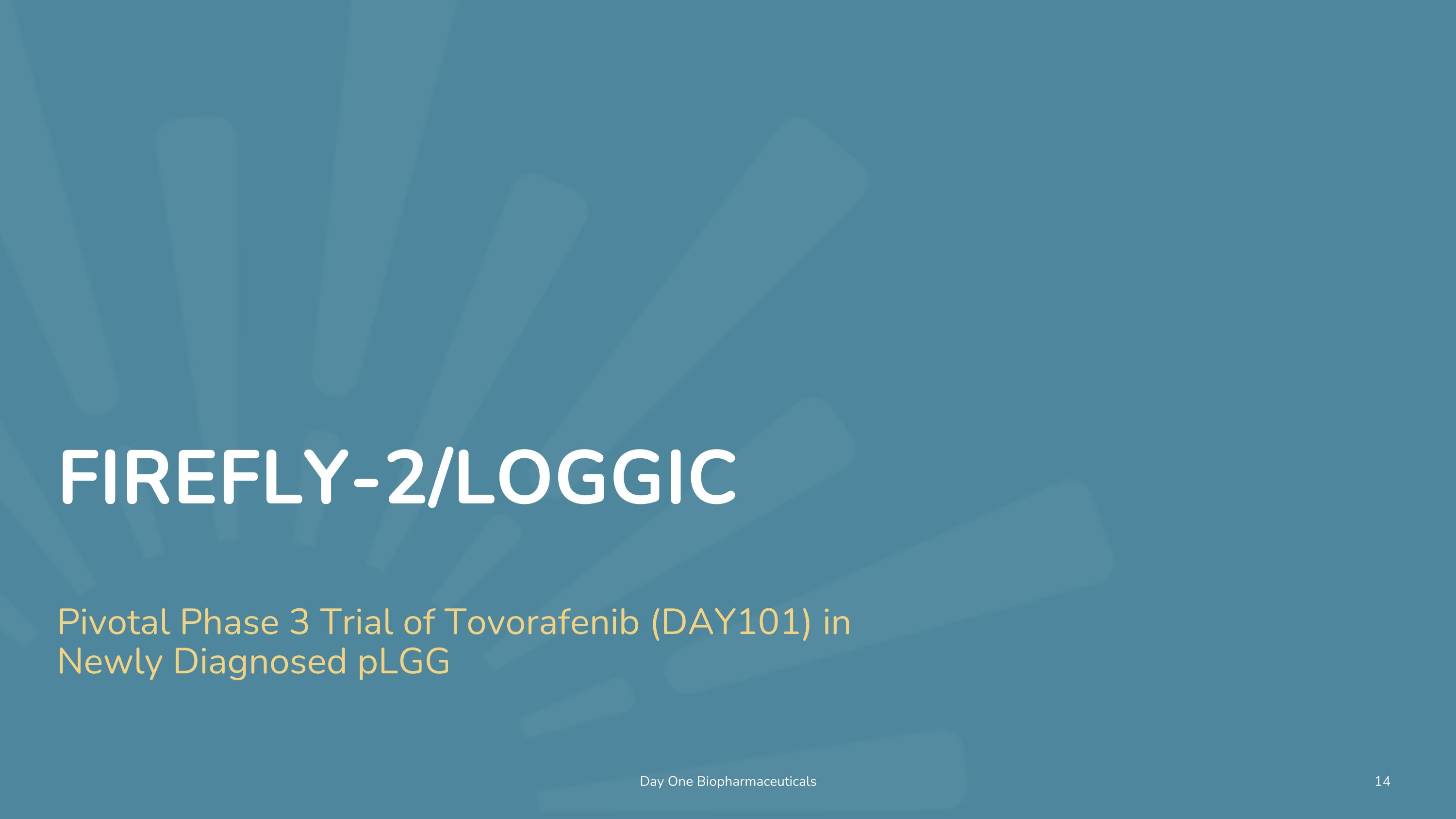
Day One Biopharmaceuticals FIREFLY-2/LOGGIC Pivotal Phase 3 Trial of Tovorafenib (DAY101) in Newly Diagnosed pLGG
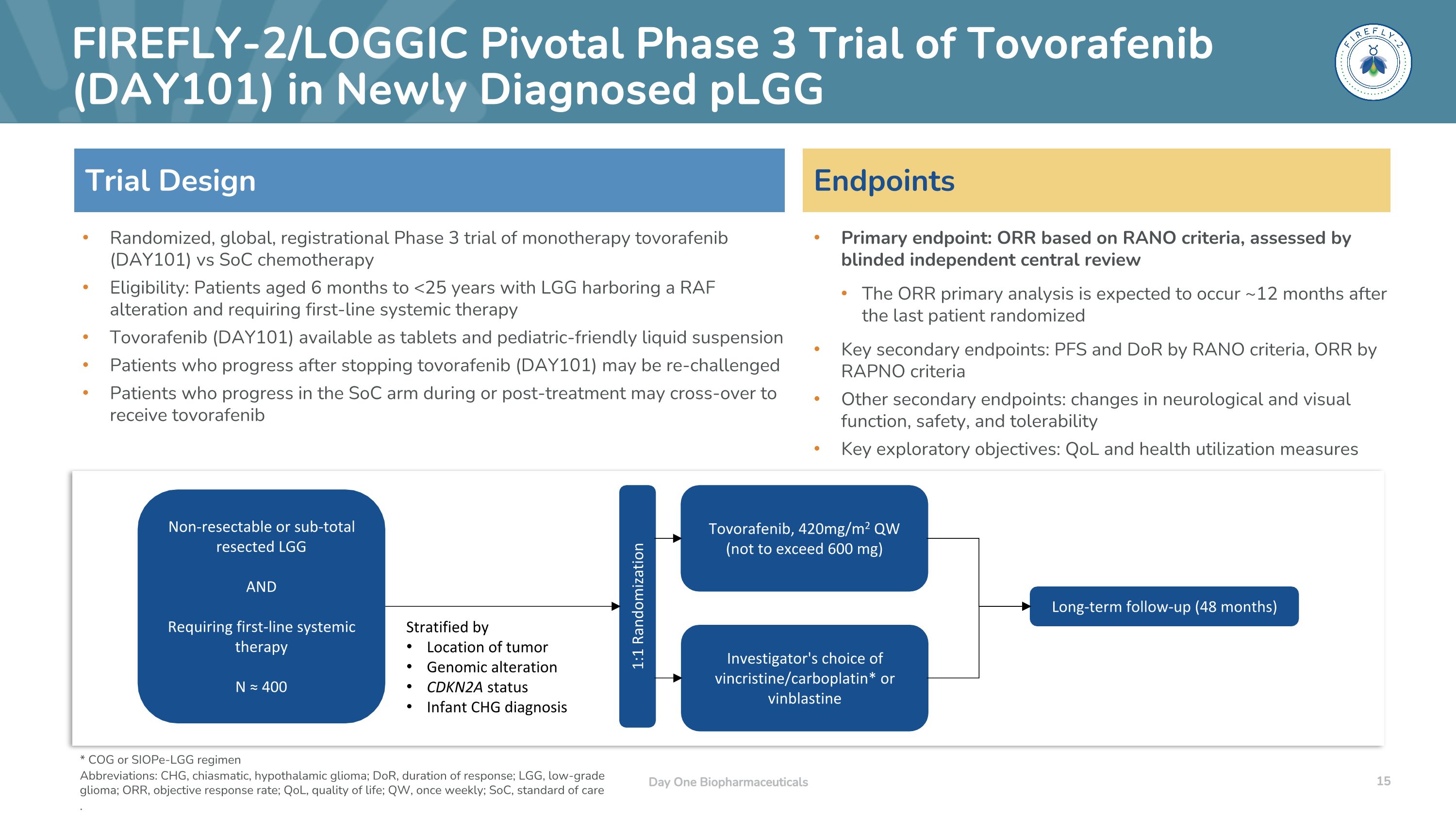
FIREFLY-2/LOGGIC Pivotal Phase 3 Trial of Tovorafenib �(DAY101) in Newly Diagnosed pLGG Day One Biopharmaceuticals Primary endpoint: ORR based on RANO criteria, assessed by blinded independent central review The ORR primary analysis is expected to occur ~12 months after the last patient randomized Key secondary endpoints: PFS and DoR by RANO criteria, ORR by RAPNO criteria Other secondary endpoints: changes in neurological and visual function, safety, and tolerability Key exploratory objectives: QoL and health utilization measures Randomized, global, registrational Phase 3 trial of monotherapy tovorafenib (DAY101) vs SoC chemotherapy Eligibility: Patients aged 6 months to <25 years with LGG harboring a RAF alteration and requiring first-line systemic therapy Tovorafenib (DAY101) available as tablets and pediatric-friendly liquid suspension Patients who progress after stopping tovorafenib (DAY101) may be re-challenged Patients who progress in the SoC arm during or post-treatment may cross-over to receive tovorafenib Endpoints Trial Design 1:1 Randomization Tovorafenib, 420mg/m2 QW (not to exceed 600 mg) Investigator's choice of vincristine/carboplatin* or vinblastine Long-term follow-up (48 months) Stratified by Location of tumor Genomic alteration CDKN2A status Infant CHG diagnosis Non-resectable or sub-total resected LGG AND Requiring first-line systemic therapy N ≈ 400 * COG or SIOPe-LGG regimen Abbreviations: CHG, chiasmatic, hypothalamic glioma; DoR, duration of response; LGG, low-grade glioma; ORR, objective response rate; QoL, quality of life; QW, once weekly; SoC, standard of care .
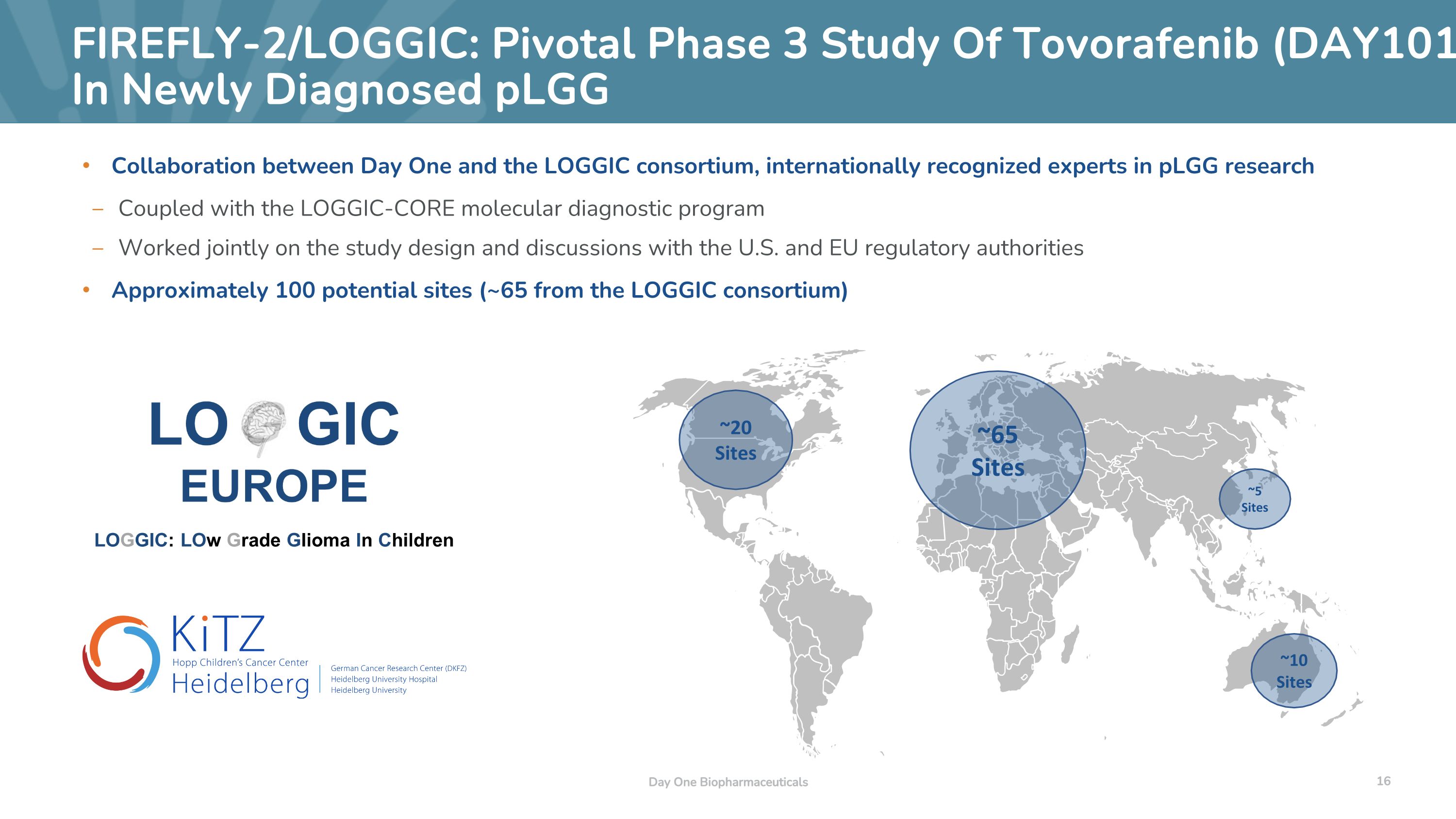
FIREFLY-2/LOGGIC: Pivotal Phase 3 Study Of Tovorafenib (DAY101) In Newly Diagnosed pLGG Day One Biopharmaceuticals Collaboration between Day One and the LOGGIC consortium, internationally recognized experts in pLGG research Coupled with the LOGGIC-CORE molecular diagnostic program Worked jointly on the study design and discussions with the U.S. and EU regulatory authorities Approximately 100 potential sites (~65 from the LOGGIC consortium) ~65 Sites ~20 Sites ~10 Sites ~5 Sites
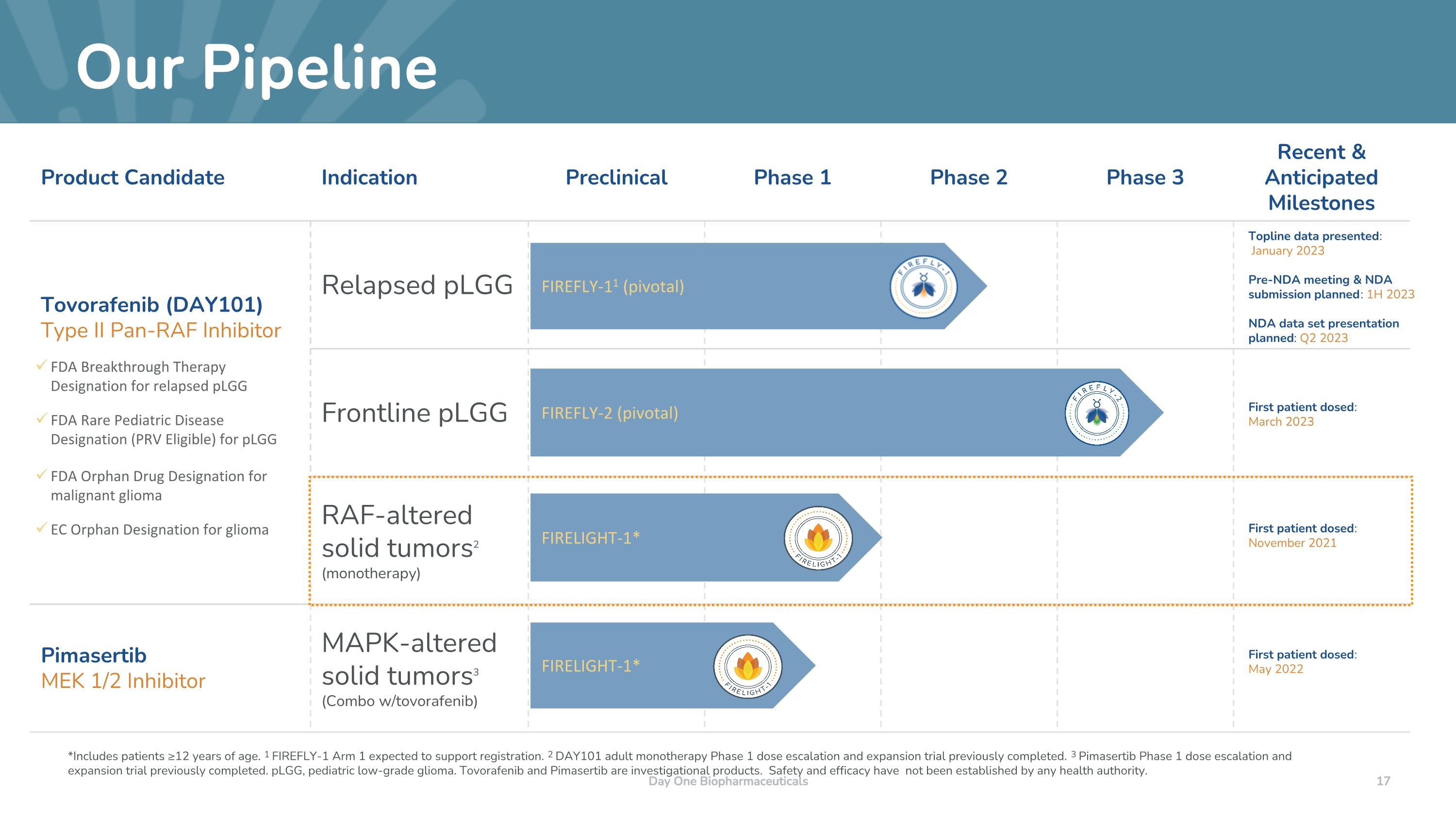
Product Candidate Indication Preclinical Phase 1 Phase 2 Phase 3 Recent & Anticipated Milestones Tovorafenib (DAY101) Type II Pan-RAF Inhibitor Relapsed pLGG Frontline pLGG RAF-altered solid tumors2 (monotherapy) Pimasertib MEK 1/2 Inhibitor MAPK-altered solid tumors3 (Combo w/tovorafenib) Our Pipeline *Includes patients ≥12 years of age. 1 FIREFLY-1 Arm 1 expected to support registration. 2 DAY101 adult monotherapy Phase 1 dose escalation and expansion trial previously completed. 3 Pimasertib Phase 1 dose escalation and expansion trial previously completed. pLGG, pediatric low-grade glioma. Tovorafenib and Pimasertib are investigational products. Safety and efficacy have not been established by any health authority. Day One Biopharmaceuticals FDA Breakthrough Therapy Designation for relapsed pLGG FDA Orphan Drug Designation for malignant glioma EC Orphan Designation for glioma FDA Rare Pediatric Disease Designation (PRV Eligible) for pLGG FIREFLY-11 (pivotal) FIREFLY-2 (pivotal) FIRELIGHT-1* FIRELIGHT-1* First patient dosed: November 2021 First patient dosed: May 2022 Topline data presented: January 2023 Pre-NDA meeting & NDA submission planned: 1H 2023 NDA data set presentation planned: Q2 2023 First patient dosed: March 2023
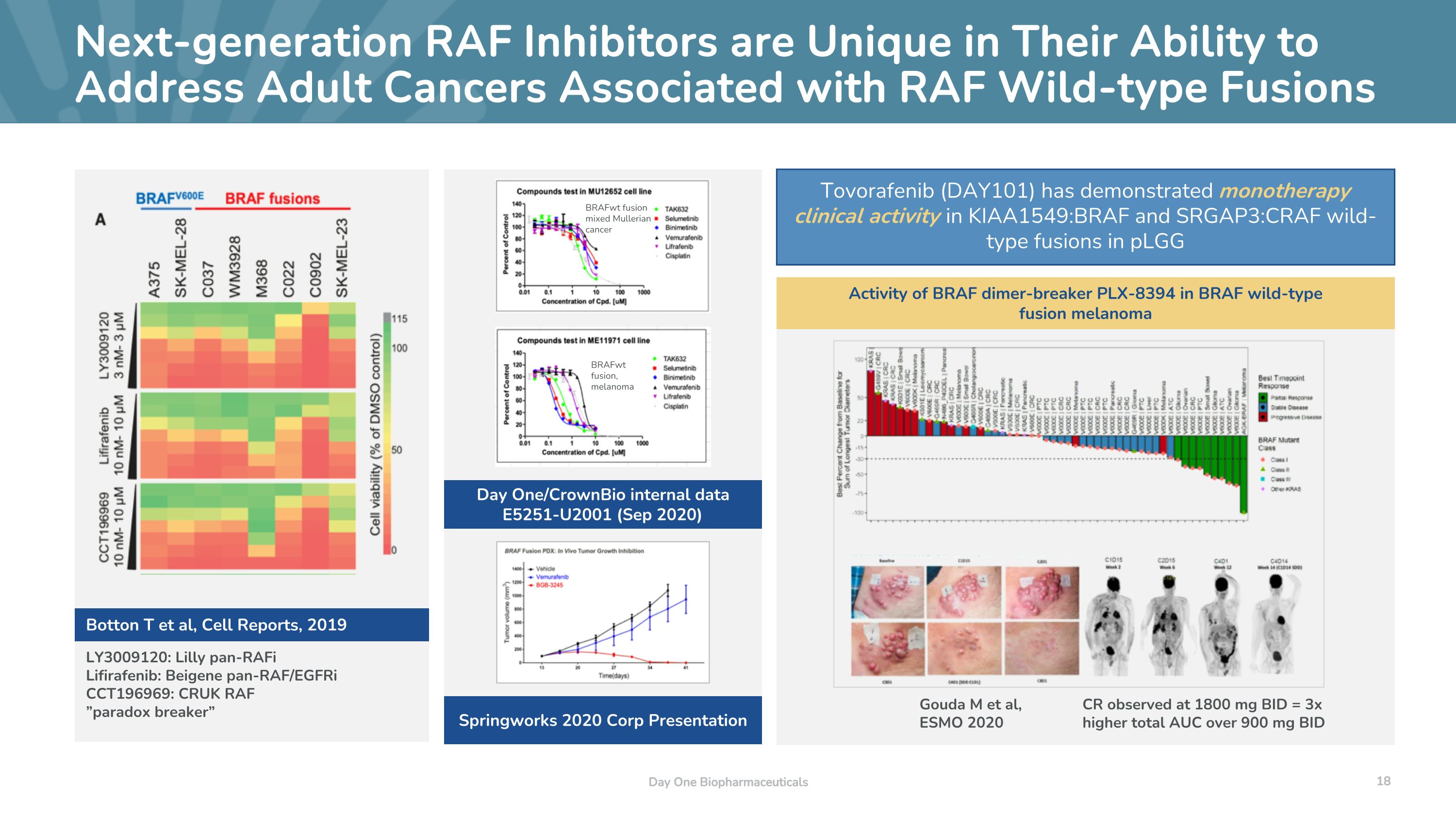
Next-generation RAF Inhibitors are Unique in Their Ability to Address Adult Cancers Associated with RAF Wild-type Fusions Day One Biopharmaceuticals Botton T et al, Cell Reports, 2019 LY3009120: Lilly pan-RAFi Lifirafenib: Beigene pan-RAF/EGFRi CCT196969: CRUK RAF �”paradox breaker” BRAFwt fusion mixed Mullerian cancer BRAFwt fusion, melanoma Springworks 2020 Corp Presentation Day One/CrownBio internal data E5251-U2001 (Sep 2020) Gouda M et al,�ESMO 2020 CR observed at 1800 mg BID = 3x higher total AUC over 900 mg BID Activity of BRAF dimer-breaker PLX-8394 in BRAF wild-type fusion melanoma Tovorafenib (DAY101) has demonstrated monotherapy clinical activity in KIAA1549:BRAF and SRGAP3:CRAF wild-type fusions in pLGG
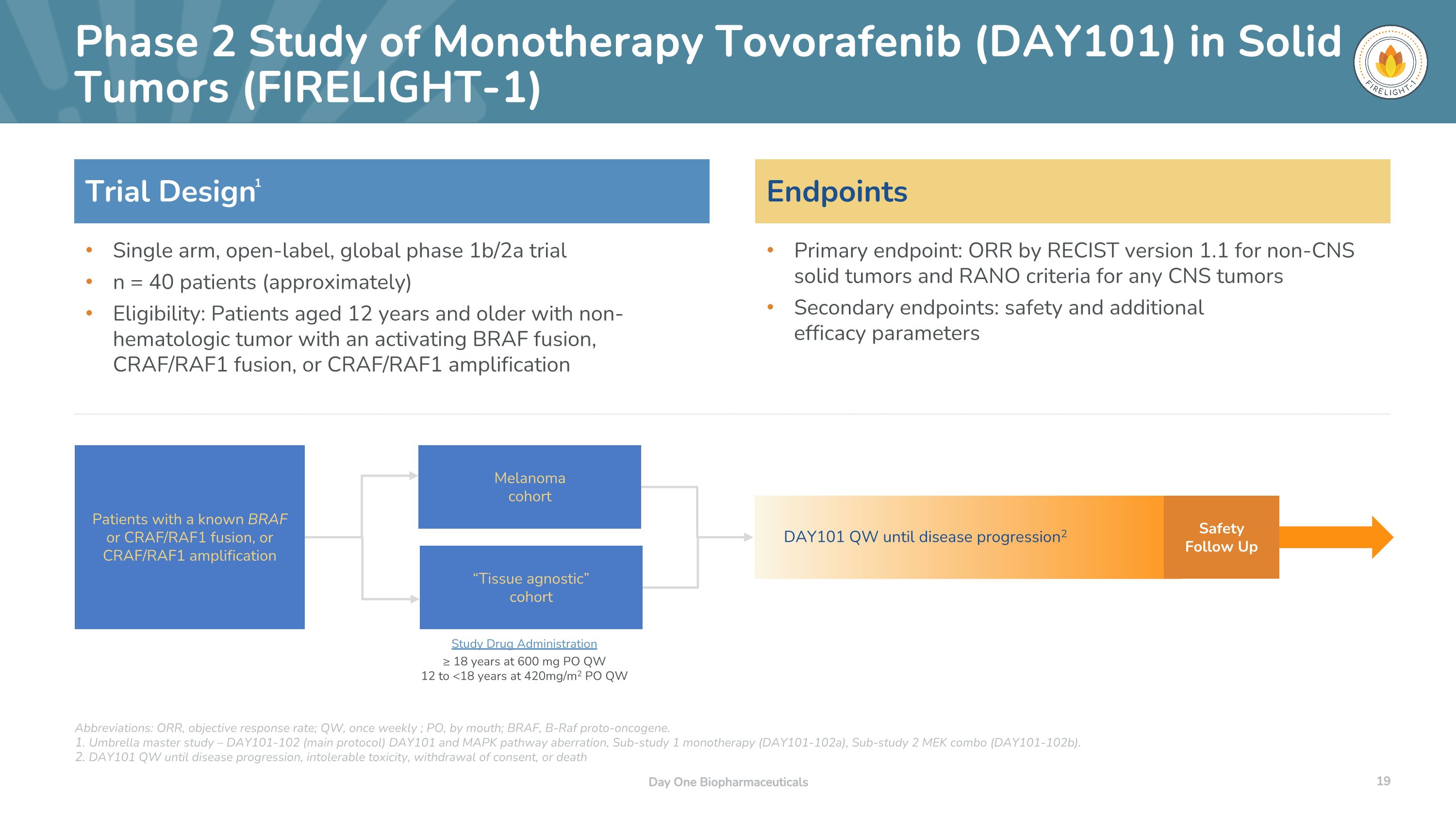
Phase 2 Study of Monotherapy Tovorafenib (DAY101) in Solid Tumors (FIRELIGHT-1) Day One Biopharmaceuticals Abbreviations: ORR, objective response rate; QW, once weekly ; PO, by mouth; BRAF, B-Raf proto-oncogene. Umbrella master study – DAY101-102 (main protocol) DAY101 and MAPK pathway aberration, Sub-study 1 monotherapy (DAY101-102a), Sub-study 2 MEK combo (DAY101-102b). DAY101 QW until disease progression, intolerable toxicity, withdrawal of consent, or death Primary endpoint: ORR by RECIST version 1.1 for non-CNS solid tumors and RANO criteria for any CNS tumors Secondary endpoints: safety and additional �efficacy parameters Single arm, open-label, global phase 1b/2a trial n = 40 patients (approximately) Eligibility: Patients aged 12 years and older with non-hematologic tumor with an activating BRAF fusion, CRAF/RAF1 fusion, or CRAF/RAF1 amplification Endpoints Trial Design1 Patients with a known BRAF or CRAF/RAF1 fusion, or CRAF/RAF1 amplification Melanoma cohort “Tissue agnostic” cohort Study Drug Administration ≥ 18 years at 600 mg PO QW 12 to <18 years at 420mg/m2 PO QW DAY101 QW until disease progression2 Safety Follow Up
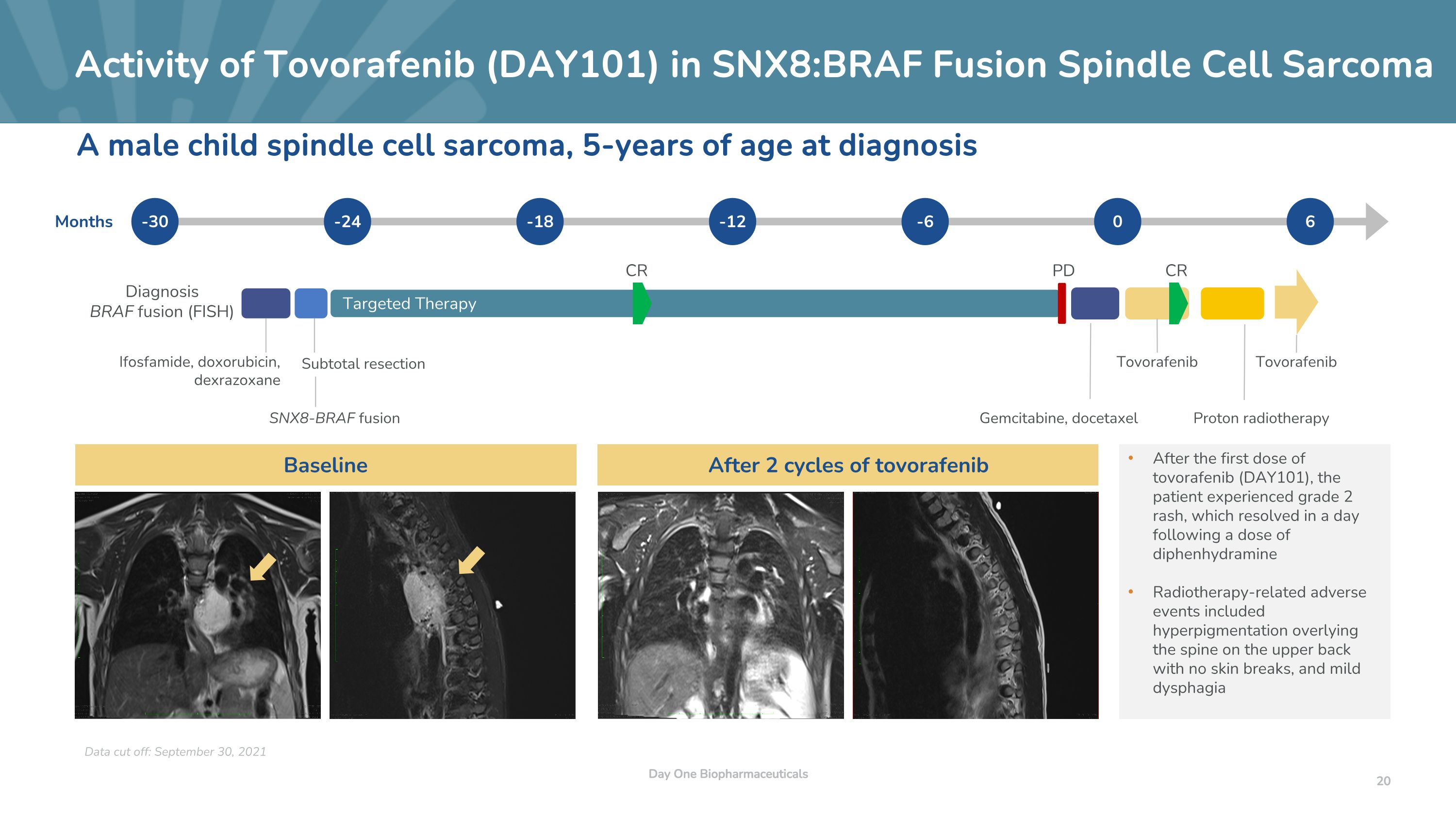
Activity of Tovorafenib (DAY101) in SNX8:BRAF Fusion Spindle Cell Sarcoma Day One Biopharmaceuticals A male child spindle cell sarcoma, 5-years of age at diagnosis Data cut off: September 30, 2021 Months -30 -24 -18 -12 -6 0 6 Diagnosis BRAF fusion (FISH) CR PD CR Gemcitabine, docetaxel Proton radiotherapy SNX8-BRAF fusion Targeted Therapy Subtotal resection Ifosfamide, doxorubicin, dexrazoxane Tovorafenib Tovorafenib After 2 cycles of tovorafenib Baseline After the first dose of tovorafenib (DAY101), the patient experienced grade 2 rash, which resolved in a day following a dose of diphenhydramine Radiotherapy-related adverse events included hyperpigmentation overlying the spine on the upper back with no skin breaks, and mild dysphagia
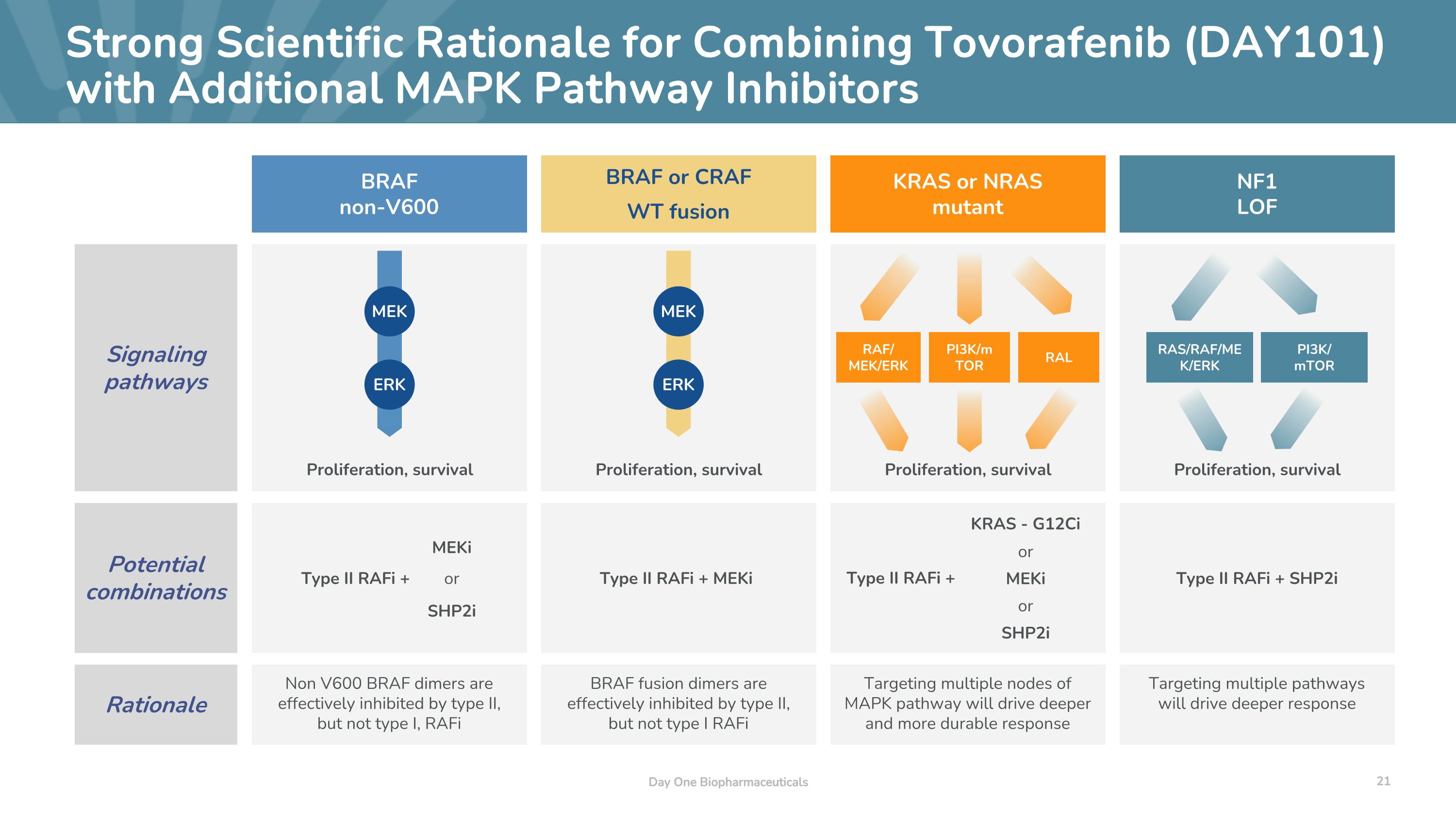
Strong Scientific Rationale for Combining Tovorafenib (DAY101) with Additional MAPK Pathway Inhibitors Day One Biopharmaceuticals Type II RAFi + MEKi Type II RAFi + SHP2i Type II RAFi + SHP2i MEKi or Type II RAFi + SHP2i MEKi or KRAS - G12Ci or Potential combinations BRAF �non-V600 BRAF or CRAF WT fusion KRAS or NRAS �mutant NF1 �LOF Rationale Non V600 BRAF dimers are effectively inhibited by type II, �but not type I, RAFi BRAF fusion dimers are effectively inhibited by type II, �but not type I RAFi Targeting multiple nodes of MAPK pathway will drive deeper and more durable response Targeting multiple pathways �will drive deeper response Signaling pathways Proliferation, survival MEK ERK Proliferation, survival RAS/RAF/MEK/ERK PI3K/ mTOR Proliferation, survival RAF/ MEK/ERK RAL PI3K/m TOR Proliferation, survival MEK ERK
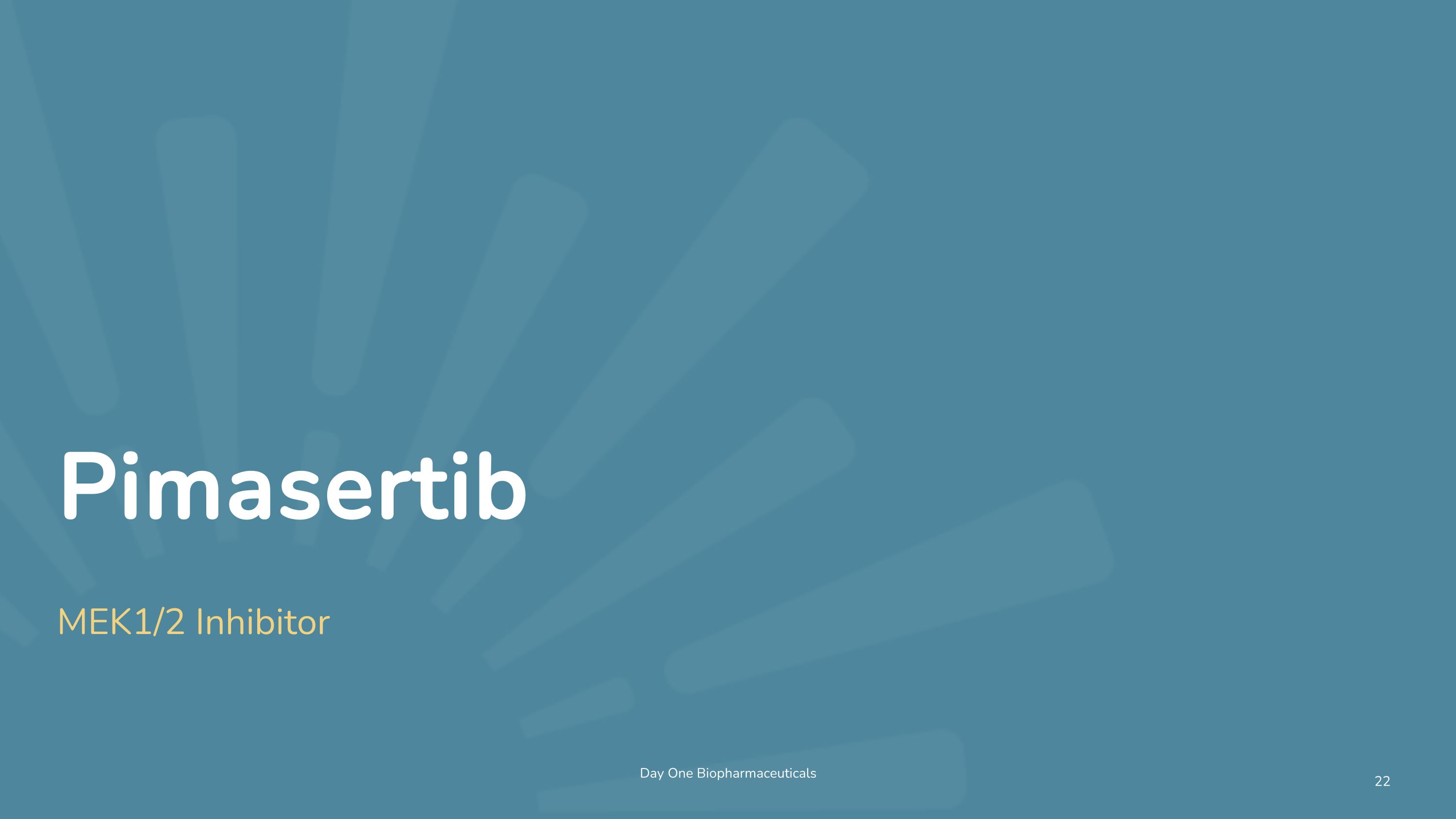
Day One Biopharmaceuticals Pimasertib MEK1/2 Inhibitor
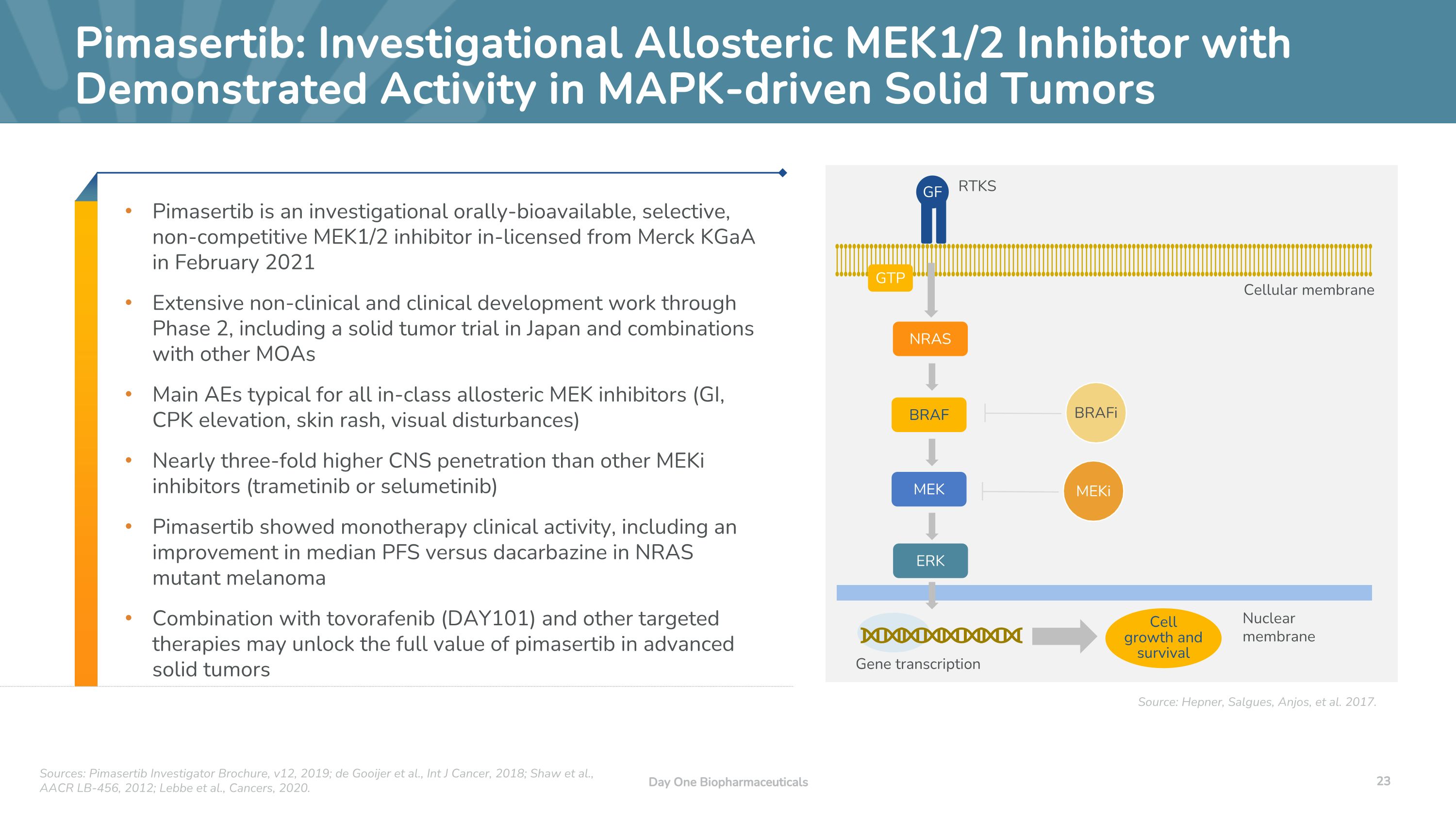
Pimasertib: Investigational Allosteric MEK1/2 Inhibitor with Demonstrated Activity in MAPK-driven Solid Tumors Day One Biopharmaceuticals Pimasertib is an investigational orally-bioavailable, selective, non-competitive MEK1/2 inhibitor in-licensed from Merck KGaA in February 2021 Extensive non-clinical and clinical development work through Phase 2, including a solid tumor trial in Japan and combinations with other MOAs Main AEs typical for all in-class allosteric MEK inhibitors (GI, CPK elevation, skin rash, visual disturbances) Nearly three-fold higher CNS penetration than other MEKi inhibitors (trametinib or selumetinib) Pimasertib showed monotherapy clinical activity, including an improvement in median PFS versus dacarbazine in NRAS mutant melanoma Combination with tovorafenib (DAY101) and other targeted therapies may unlock the full value of pimasertib in advanced solid tumors Sources: Pimasertib Investigator Brochure, v12, 2019; de Gooijer et al., Int J Cancer, 2018; Shaw et al., AACR LB-456, 2012; Lebbe et al., Cancers, 2020. GF RTKS NRAS BRAF MEK ERK Cell�growth and survival Nuclear membrane GTP Gene transcription Cellular membrane MEKi BRAFi Source: Hepner, Salgues, Anjos, et al. 2017.

Vertical MAPK Pathway Inhibition with Tovorafenib (DAY101) and Pimasertib May Unlock Potential Synergy for Adult Solid Tumors Day One Biopharmaceuticals Mechanistic model for vertical MAPK pathway inhibition (modified from Yen et al. Cancer Cell, 2018) . DAY101 + MEK inhibitor is synergistic in KRAS G12C and Q61 mutant tumor cell models (Day One internal data) Sensitivity of KRAS Q61 mutant cells to pimasertib is enhanced when cells are treated with the type II RAF inhibitor BGB-283 (Yuan et al., Mol Onc 2020) The MAPK pathway normally has multiple feedback loops that negatively regulate upstream (RAS/RAF) activation to ensure optimal signaling Monotherapy MEK inhibition disables these feedback loops and induces RAS signaling as well as RAF dimerization �and activation Combination therapy with a MEK inhibitor and type II RAF inhibitor is synergistic in KRASmut and BRAFmut tumor models Modified from Yen et al. Cancer Cell, 2018 A B C A B C
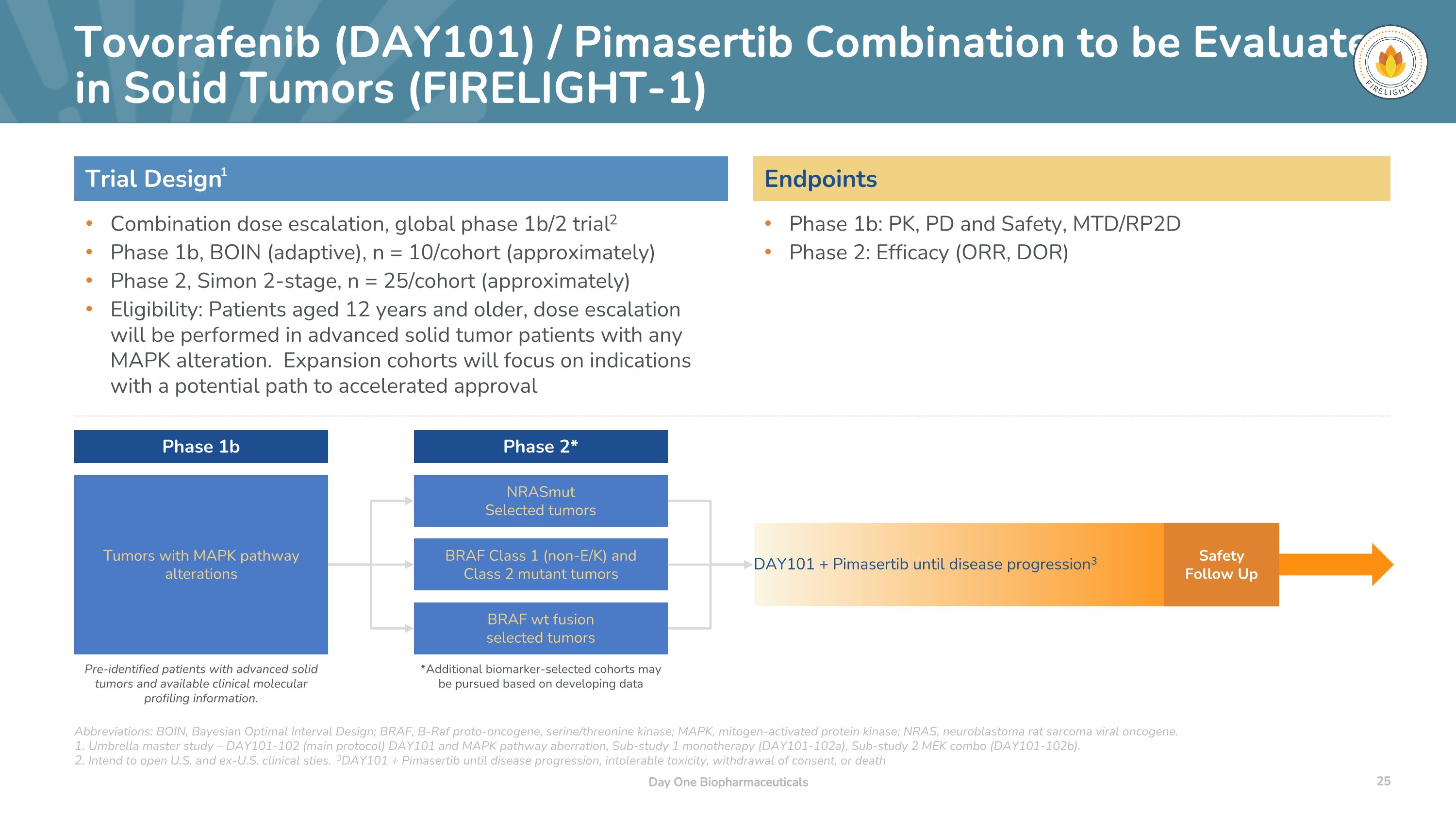
Tovorafenib (DAY101) / Pimasertib Combination to be Evaluated in Solid Tumors (FIRELIGHT-1) Day One Biopharmaceuticals Abbreviations: BOIN, Bayesian Optimal Interval Design; BRAF, B-Raf proto-oncogene, serine/threonine kinase; MAPK, mitogen-activated protein kinase; NRAS, neuroblastoma rat sarcoma viral oncogene. Umbrella master study – DAY101-102 (main protocol) DAY101 and MAPK pathway aberration, Sub-study 1 monotherapy (DAY101-102a), Sub-study 2 MEK combo (DAY101-102b). Intend to open U.S. and ex-U.S. clinical sties. 3DAY101 + Pimasertib until disease progression, intolerable toxicity, withdrawal of consent, or death Phase 1b: PK, PD and Safety, MTD/RP2D Phase 2: Efficacy (ORR, DOR) Combination dose escalation, global phase 1b/2 trial2 Phase 1b, BOIN (adaptive), n = 10/cohort (approximately) Phase 2, Simon 2-stage, n = 25/cohort (approximately) Eligibility: Patients aged 12 years and older, dose escalation will be performed in advanced solid tumor patients with any MAPK alteration. Expansion cohorts will focus on indications with a potential path to accelerated approval Endpoints Trial Design1 Pre-identified patients with advanced solid tumors and available clinical molecular profiling information. Phase 1b Tumors with MAPK pathway alterations *Additional biomarker-selected cohorts may be pursued based on developing data Phase 2* NRASmut Selected tumors BRAF wt fusion selected tumors BRAF Class 1 (non-E/K) and Class 2 mutant tumors DAY101 + Pimasertib until disease progression3 Safety Follow Up

Day One Biopharmaceuticals Summary
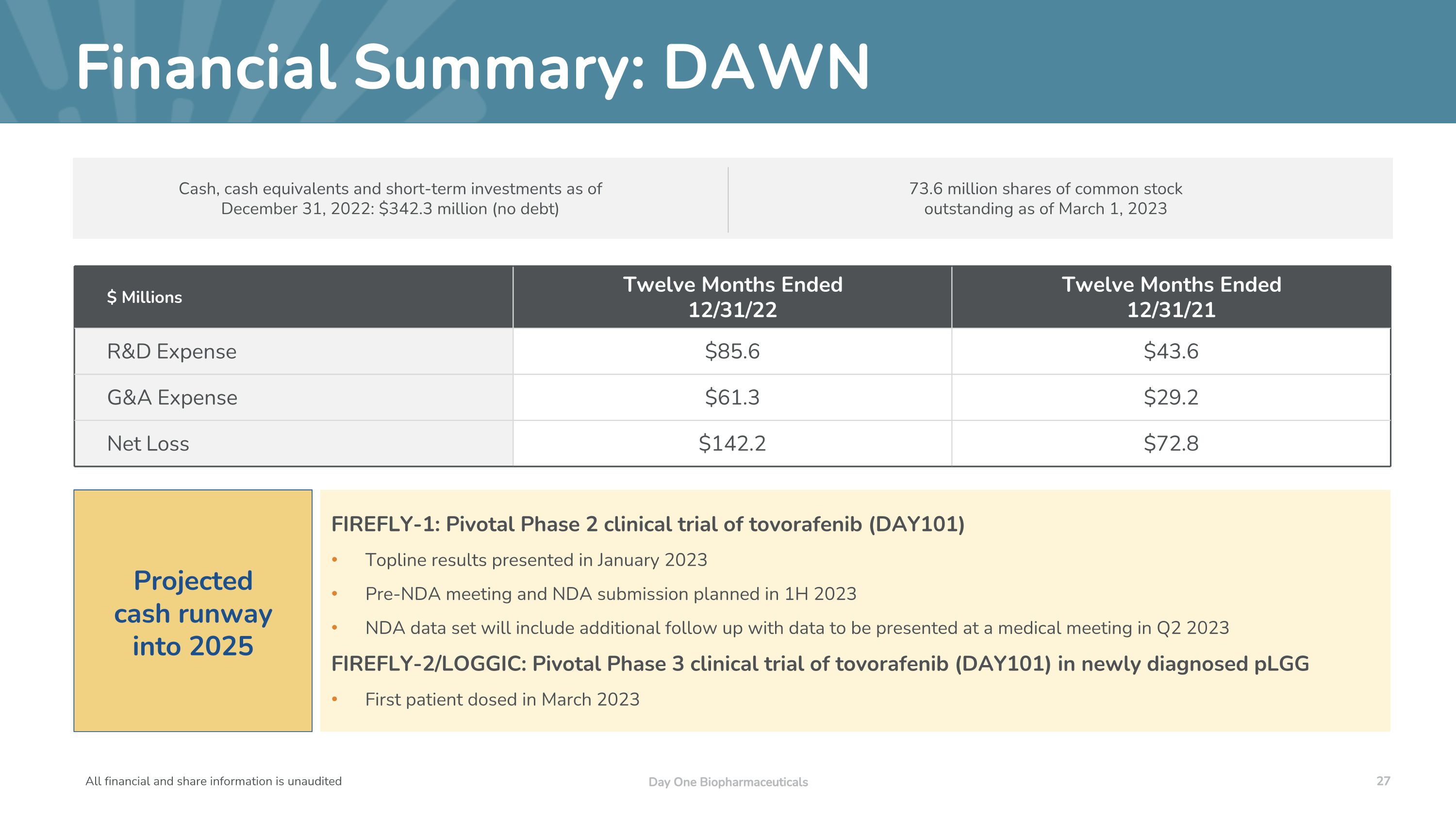
Financial Summary: DAWN Day One Biopharmaceuticals $ Millions Twelve Months Ended�12/31/22 Twelve Months Ended�12/31/21 R&D Expense $85.6 $43.6 G&A Expense $61.3 $29.2 Net Loss $142.2 $72.8 FIREFLY-1: Pivotal Phase 2 clinical trial of tovorafenib (DAY101) Topline results presented in January 2023 Pre-NDA meeting and NDA submission planned in 1H 2023 NDA data set will include additional follow up with data to be presented at a medical meeting in Q2 2023 FIREFLY-2/LOGGIC: Pivotal Phase 3 clinical trial of tovorafenib (DAY101) in newly diagnosed pLGG First patient dosed in March 2023 Cash, cash equivalents and short-term investments as of December 31, 2022: $342.3 million (no debt) 73.6 million shares of common stock outstanding as of March 1, 2023 Projected cash runway into 2025 All financial and share information is unaudited
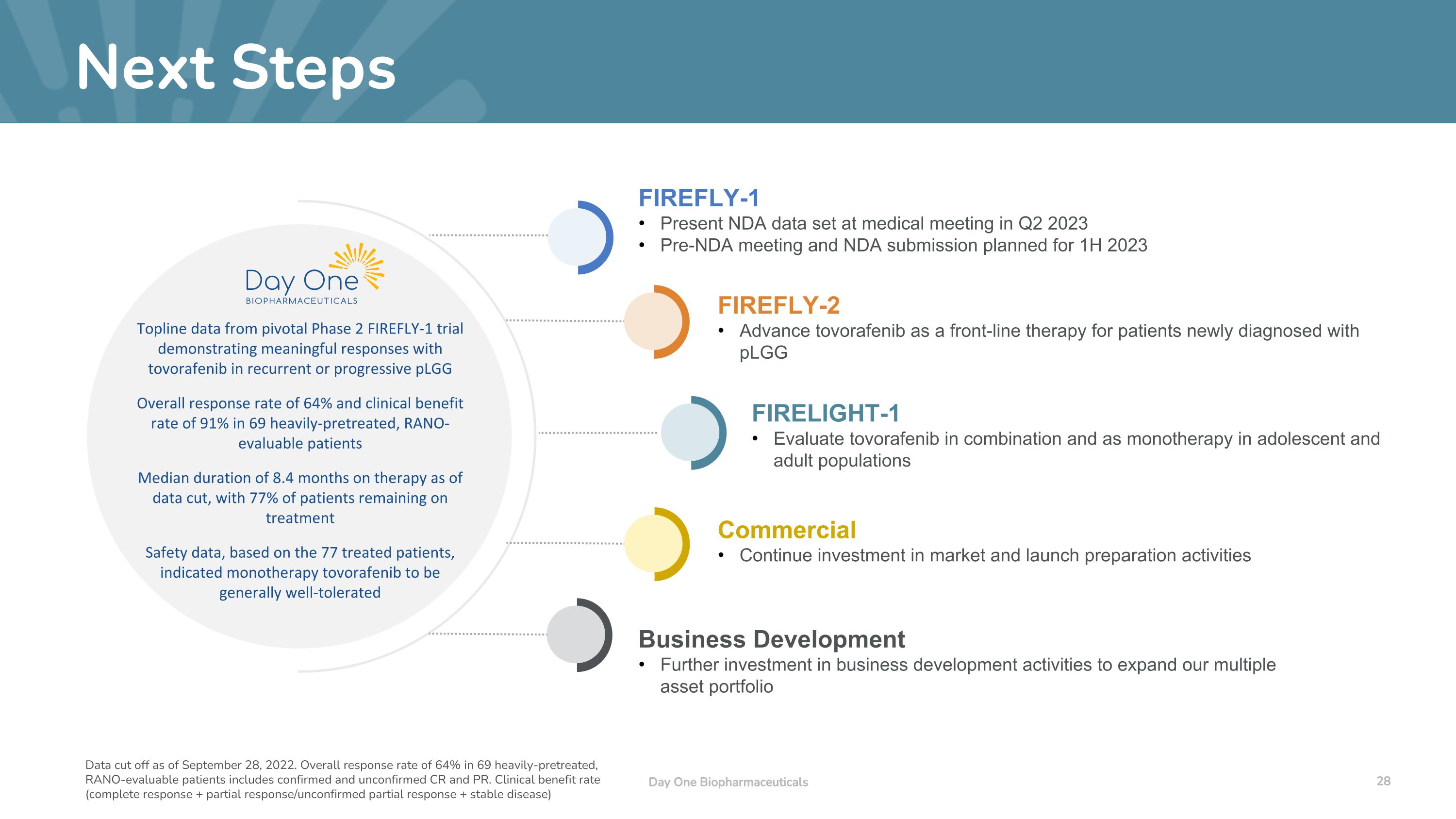
Next Steps Day One Biopharmaceuticals FIREFLY-1 Present NDA data set at medical meeting in Q2 2023 Pre-NDA meeting and NDA submission planned for 1H 2023 FIREFLY-2 Advance tovorafenib as a front-line therapy for patients newly diagnosed with pLGG Commercial Continue investment in market and launch preparation activities Topline data from pivotal Phase 2 FIREFLY-1 trial demonstrating meaningful responses with tovorafenib in recurrent or progressive pLGG Overall response rate of 64% and clinical benefit rate of 91% in 69 heavily-pretreated, RANO-evaluable patients Median duration of 8.4 months on therapy as of data cut, with 77% of patients remaining on treatment Safety data, based on the 77 treated patients, indicated monotherapy tovorafenib to be generally well-tolerated Data cut off as of September 28, 2022. Overall response rate of 64% in 69 heavily-pretreated, RANO-evaluable patients includes confirmed and unconfirmed CR and PR. Clinical benefit rate (complete response + partial response/unconfirmed partial response + stable disease) Business Development Further investment in business development activities to expand our multiple asset portfolio FIRELIGHT-1 Evaluate tovorafenib in combination and as monotherapy in adolescent and adult populations
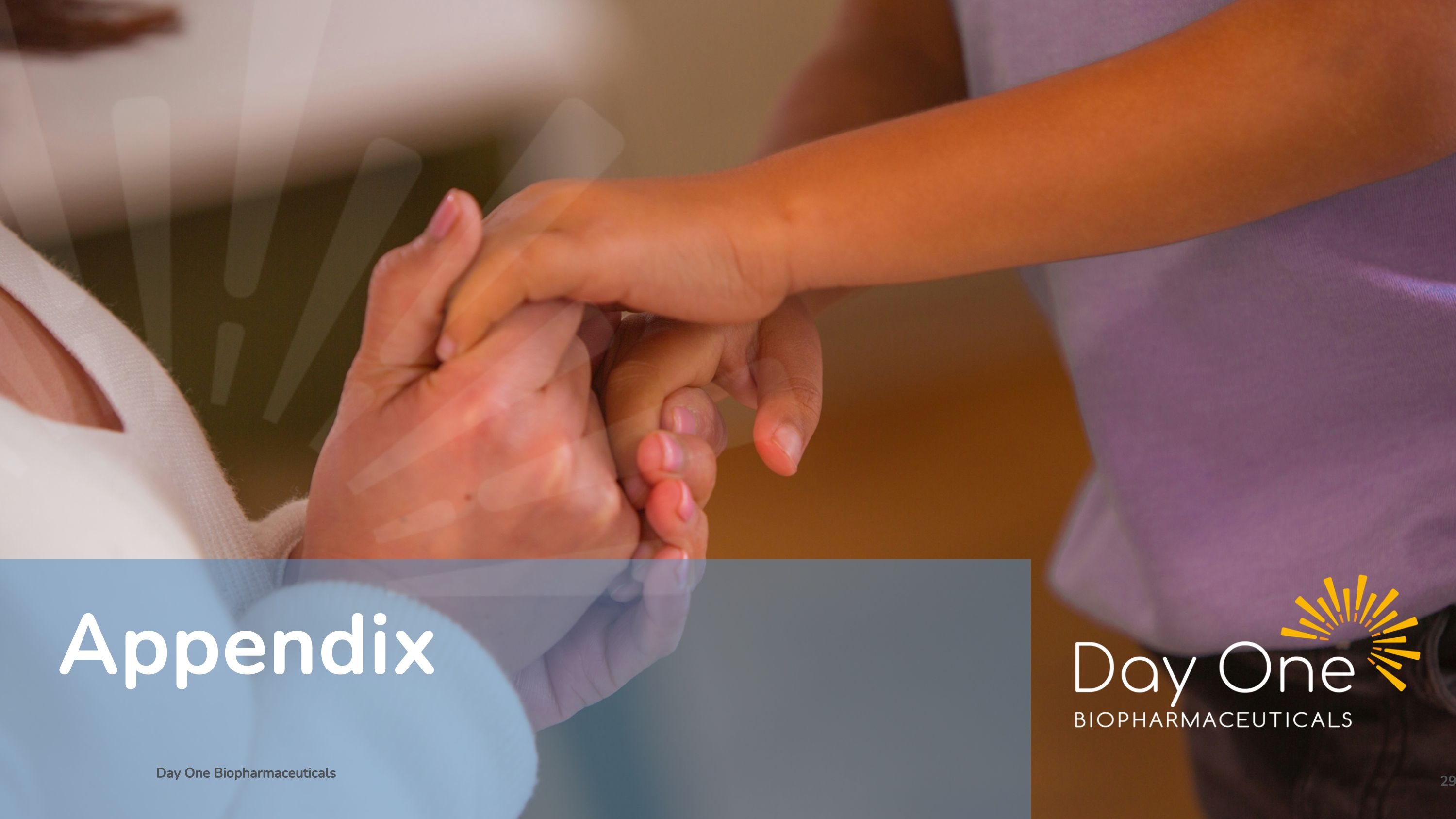
Appendix Day One Biopharmaceuticals
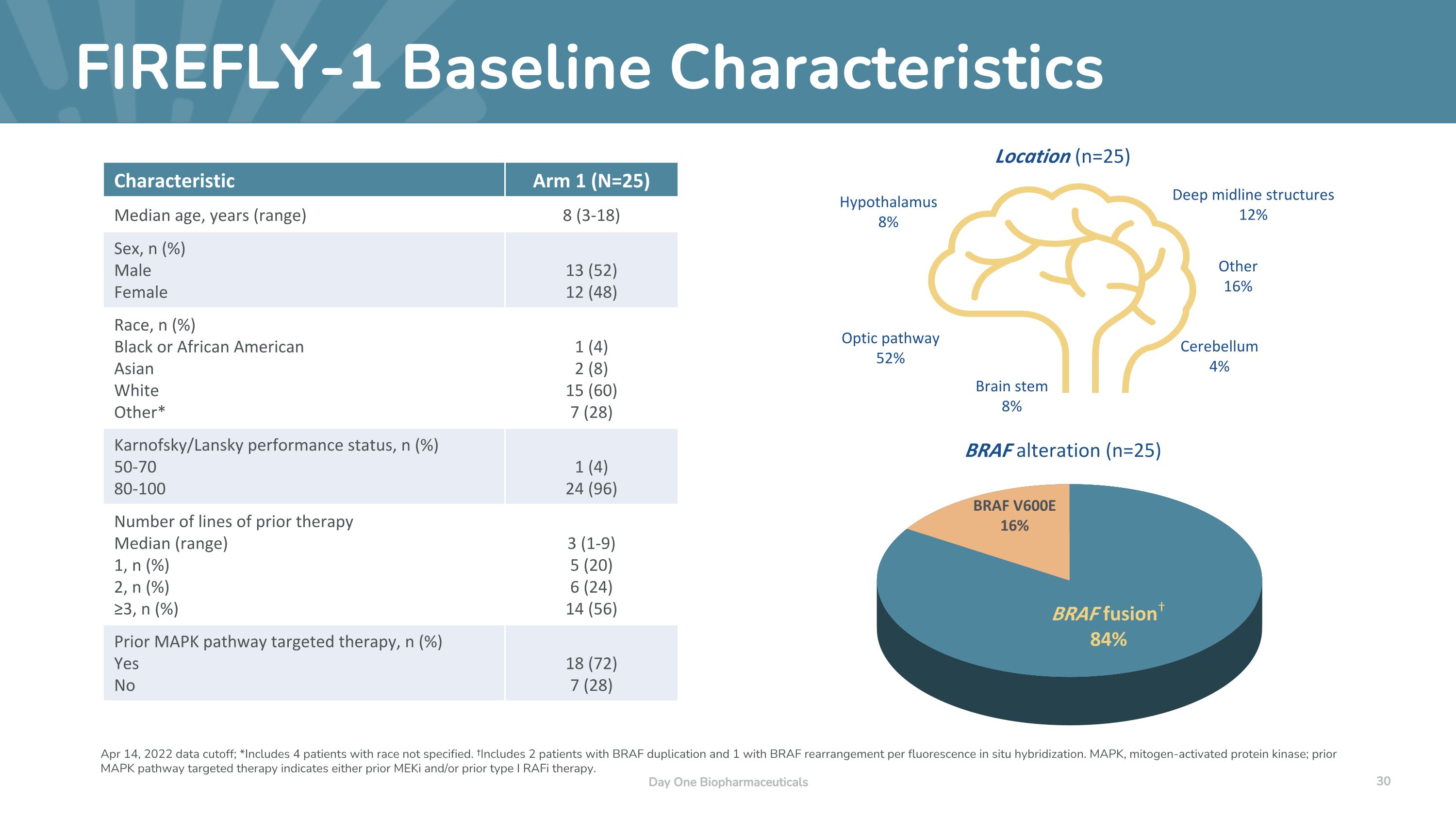
FIREFLY-1 Baseline Characteristics Day One Biopharmaceuticals Characteristic Arm 1 (N=25) Median age, years (range) 8 (3-18) Sex, n (%) Male Female 13 (52) 12 (48) Race, n (%) Black or African American Asian White Other* 1 (4) 2 (8) 15 (60) 7 (28) Karnofsky/Lansky performance status, n (%) 50-70 80-100 1 (4) 24 (96) Number of lines of prior therapy Median (range) 1, n (%) 2, n (%) ≥3, n (%) 3 (1-9) 5 (20) 6 (24) 14 (56) Prior MAPK pathway targeted therapy, n (%) Yes No 18 (72) 7 (28) Apr 14, 2022 data cutoff; *Includes 4 patients with race not specified. †Includes 2 patients with BRAF duplication and 1 with BRAF rearrangement per fluorescence in situ hybridization. MAPK, mitogen-activated protein kinase; prior MAPK pathway targeted therapy indicates either prior MEKi and/or prior type I RAFi therapy. BRAF alteration (n=25) Location (n=25) Optic pathway 52% BRAF V600E 16% BRAF fusion† 84% Cerebellum 4% Deep midline structures 12% Brain stem 8% Hypothalamus 8% Other 16%
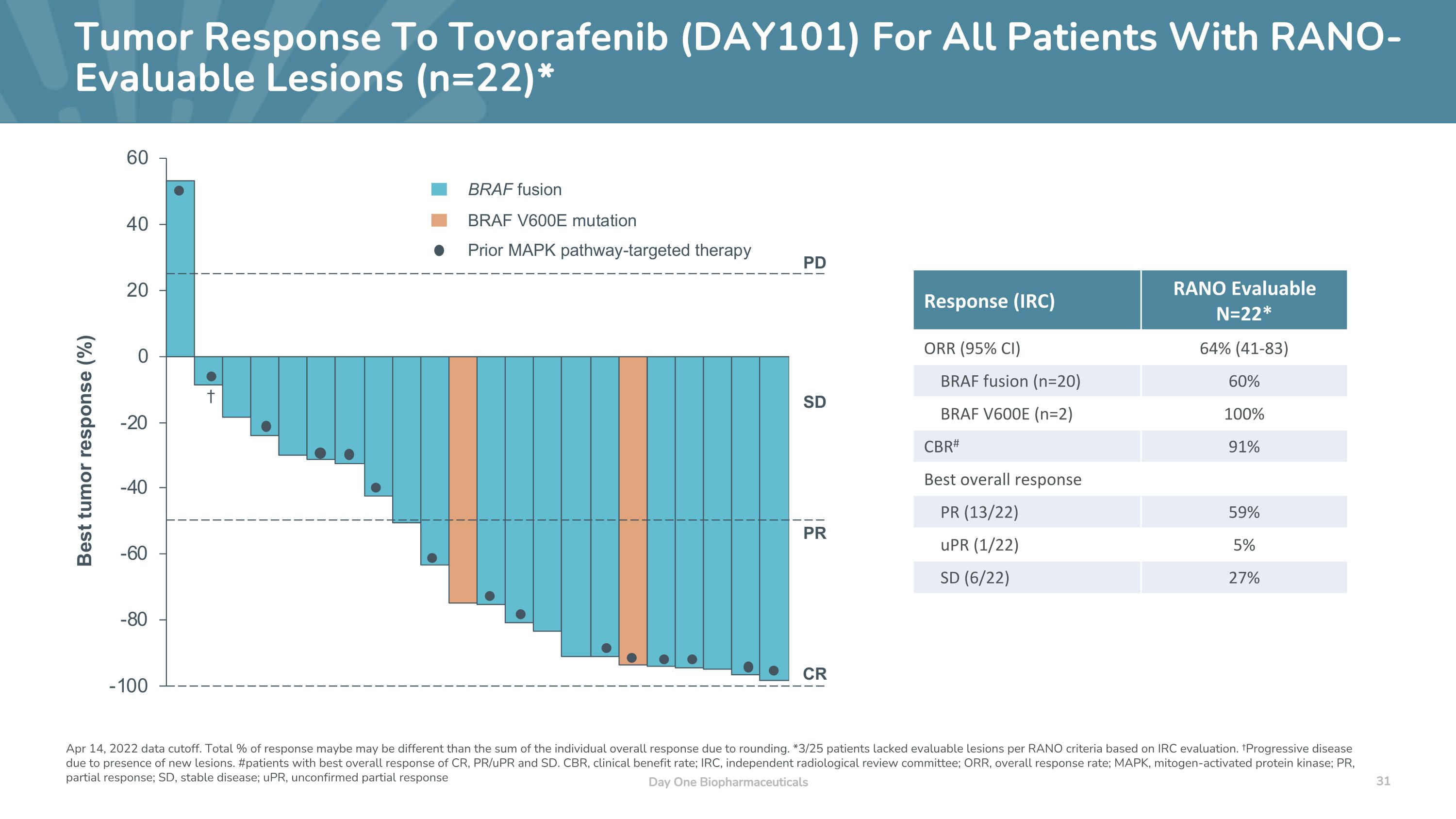
Tumor Response To Tovorafenib (DAY101) For All Patients With RANO-Evaluable Lesions (n=22)* Day One Biopharmaceuticals Response (IRC) RANO Evaluable N=22* ORR (95% CI) 64% (41-83) BRAF fusion (n=20) 60% BRAF V600E (n=2) 100% CBR# 91% Best overall response PR (13/22) 59% uPR (1/22) 5% SD (6/22) 27% Apr 14, 2022 data cutoff. Total % of response maybe may be different than the sum of the individual overall response due to rounding. *3/25 patients lacked evaluable lesions per RANO criteria based on IRC evaluation. †Progressive disease due to presence of new lesions. #patients with best overall response of CR, PR/uPR and SD. CBR, clinical benefit rate; IRC, independent radiological review committee; ORR, overall response rate; MAPK, mitogen-activated protein kinase; PR, partial response; SD, stable disease; uPR, unconfirmed partial response
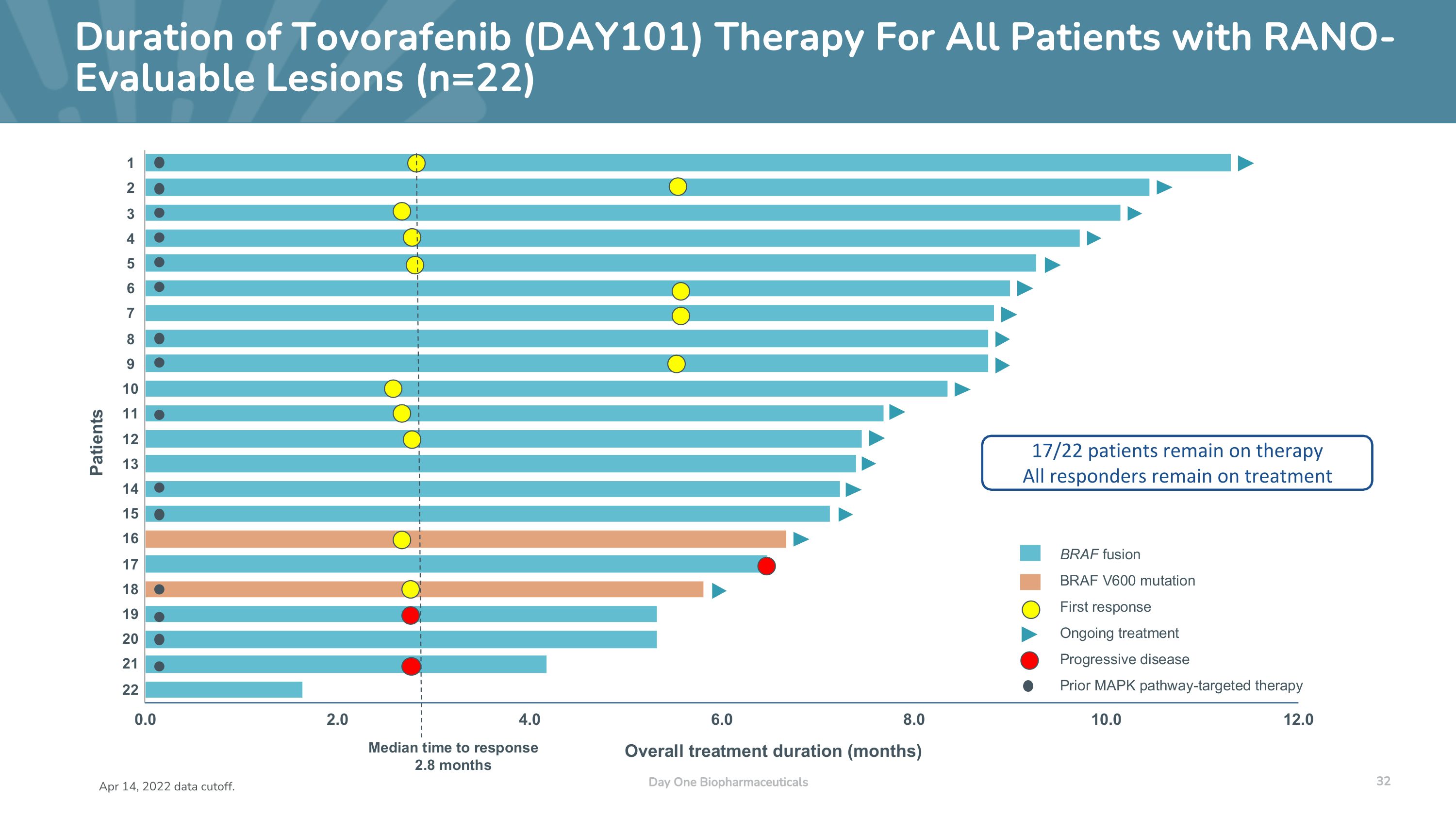
Duration of Tovorafenib (DAY101) Therapy For All Patients with RANO-Evaluable Lesions (n=22) Day One Biopharmaceuticals Apr 14, 2022 data cutoff. 17/22 patients remain on therapy All responders remain on treatment
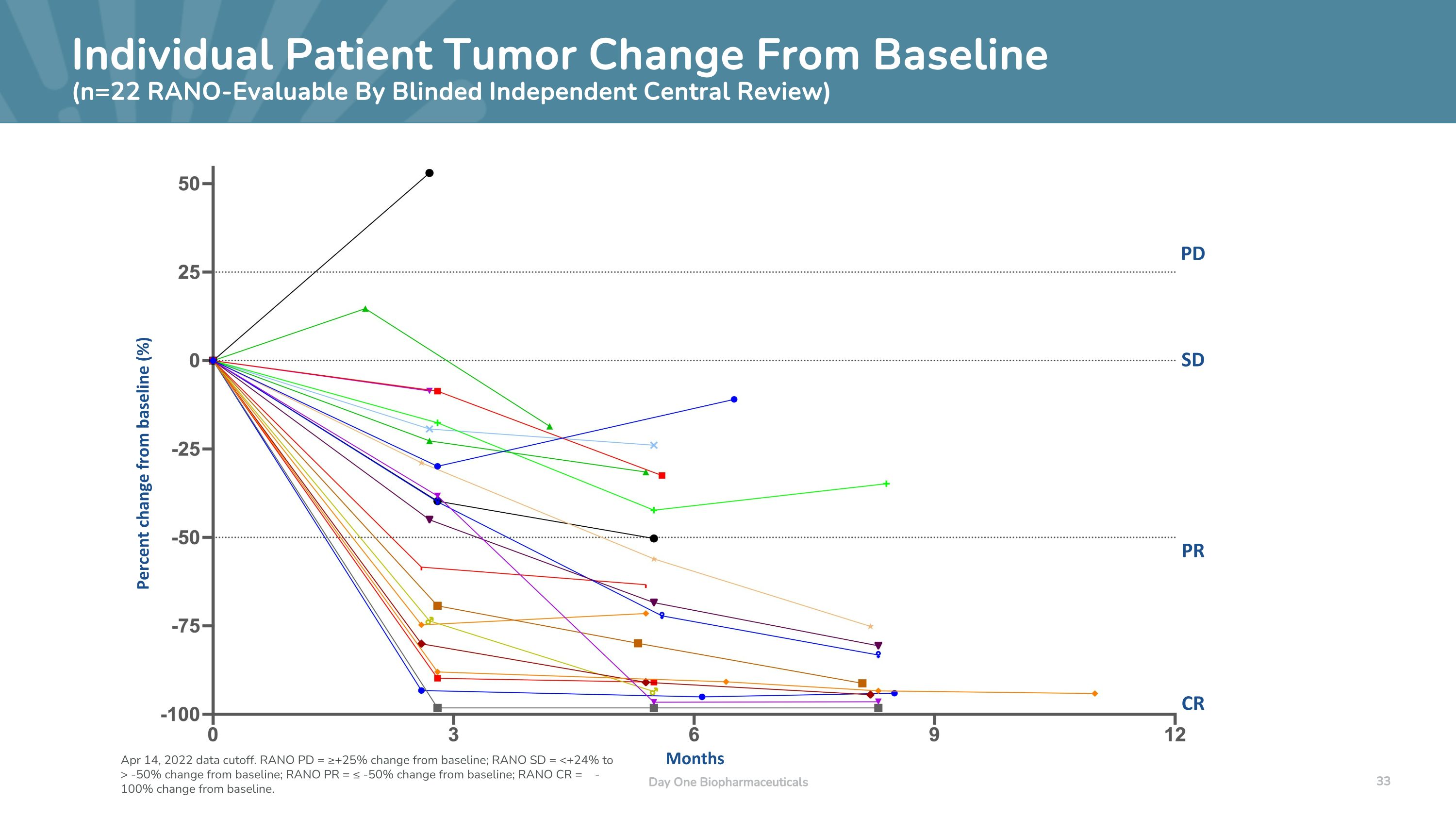
Individual Patient Tumor Change From Baseline�(n=22 RANO-Evaluable By Blinded Independent Central Review) Day One Biopharmaceuticals PR PD SD CR Percent change from baseline (%) Months Apr 14, 2022 data cutoff. RANO PD = ≥+25% change from baseline; RANO SD = <+24% to > -50% change from baseline; RANO PR = ≤ -50% change from baseline; RANO CR = -100% change from baseline.
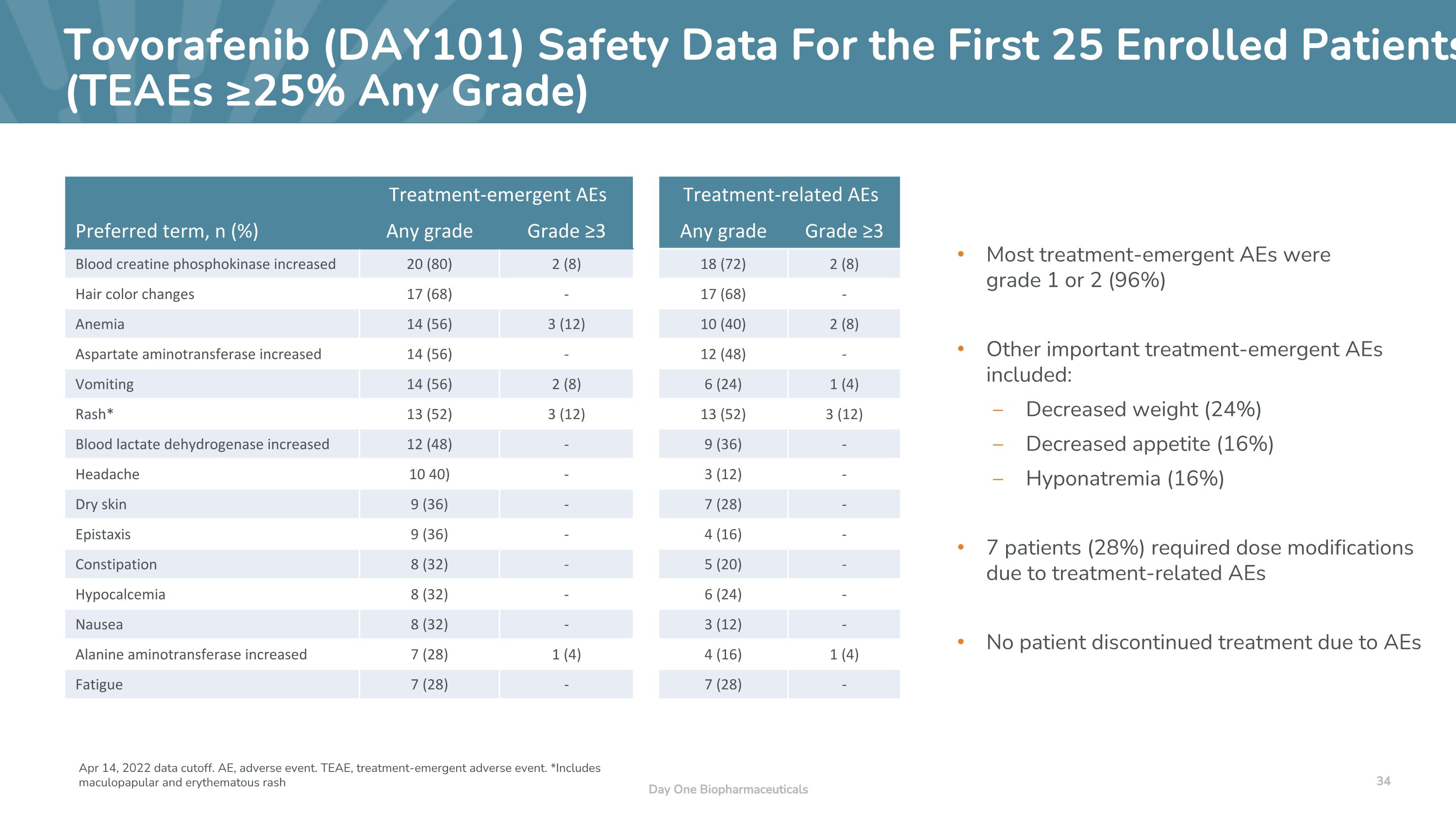
Tovorafenib (DAY101) Safety Data For the First 25 Enrolled Patients (TEAEs ≥25% Any Grade) Day One Biopharmaceuticals Preferred term, n (%) Treatment-emergent AEs Treatment-related AEs Any grade Grade ≥3 Any grade Grade ≥3 Blood creatine phosphokinase increased 20 (80) 2 (8) 18 (72) 2 (8) Hair color changes 17 (68) - 17 (68) - Anemia 14 (56) 3 (12) 10 (40) 2 (8) Aspartate aminotransferase increased 14 (56) - 12 (48) - Vomiting 14 (56) 2 (8) 6 (24) 1 (4) Rash* 13 (52) 3 (12) 13 (52) 3 (12) Blood lactate dehydrogenase increased 12 (48) - 9 (36) - Headache 10 40) - 3 (12) - Dry skin 9 (36) - 7 (28) - Epistaxis 9 (36) - 4 (16) - Constipation 8 (32) - 5 (20) - Hypocalcemia 8 (32) - 6 (24) - Nausea 8 (32) - 3 (12) - Alanine aminotransferase increased 7 (28) 1 (4) 4 (16) 1 (4) Fatigue 7 (28) - 7 (28) - Most treatment-emergent AEs were grade 1 or 2 (96%) Other important treatment-emergent AEs included: Decreased weight (24%) Decreased appetite (16%) Hyponatremia (16%) 7 patients (28%) required dose modifications due to treatment-related AEs No patient discontinued treatment due to AEs Apr 14, 2022 data cutoff. AE, adverse event. TEAE, treatment-emergent adverse event. *Includes maculopapular and erythematous rash
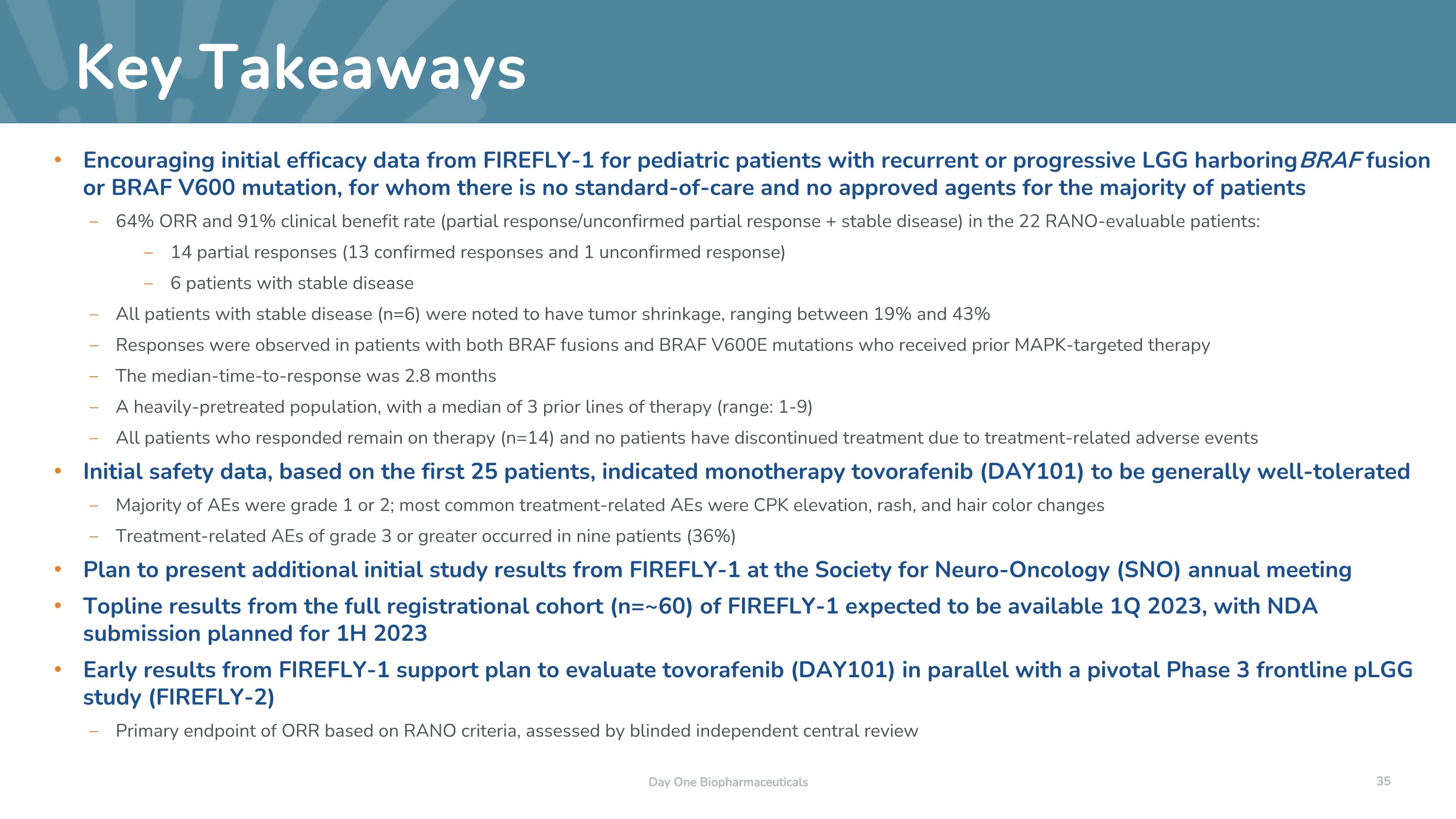
Key Takeaways Day One Biopharmaceuticals Encouraging initial efficacy data from FIREFLY-1 for pediatric patients with recurrent or progressive LGG harboring BRAF fusion or BRAF V600 mutation, for whom there is no standard-of-care and no approved agents for the majority of patients 64% ORR and 91% clinical benefit rate (partial response/unconfirmed partial response + stable disease) in the 22 RANO-evaluable patients: 14 partial responses (13 confirmed responses and 1 unconfirmed response) 6 patients with stable disease All patients with stable disease (n=6) were noted to have tumor shrinkage, ranging between 19% and 43% Responses were observed in patients with both BRAF fusions and BRAF V600E mutations who received prior MAPK-targeted therapy The median-time-to-response was 2.8 months A heavily-pretreated population, with a median of 3 prior lines of therapy (range: 1-9) All patients who responded remain on therapy (n=14) and no patients have discontinued treatment due to treatment-related adverse events Initial safety data, based on the first 25 patients, indicated monotherapy tovorafenib (DAY101) to be generally well-tolerated Majority of AEs were grade 1 or 2; most common treatment-related AEs were CPK elevation, rash, and hair color changes Treatment-related AEs of grade 3 or greater occurred in nine patients (36%) Plan to present additional initial study results from FIREFLY-1 at the Society for Neuro-Oncology (SNO) annual meeting Topline results from the full registrational cohort (n=~60) of FIREFLY-1 expected to be available 1Q 2023, with NDA submission planned for 1H 2023 Early results from FIREFLY-1 support plan to evaluate tovorafenib (DAY101) in parallel with a pivotal Phase 3 frontline pLGG study (FIREFLY-2) Primary endpoint of ORR based on RANO criteria, assessed by blinded independent central review
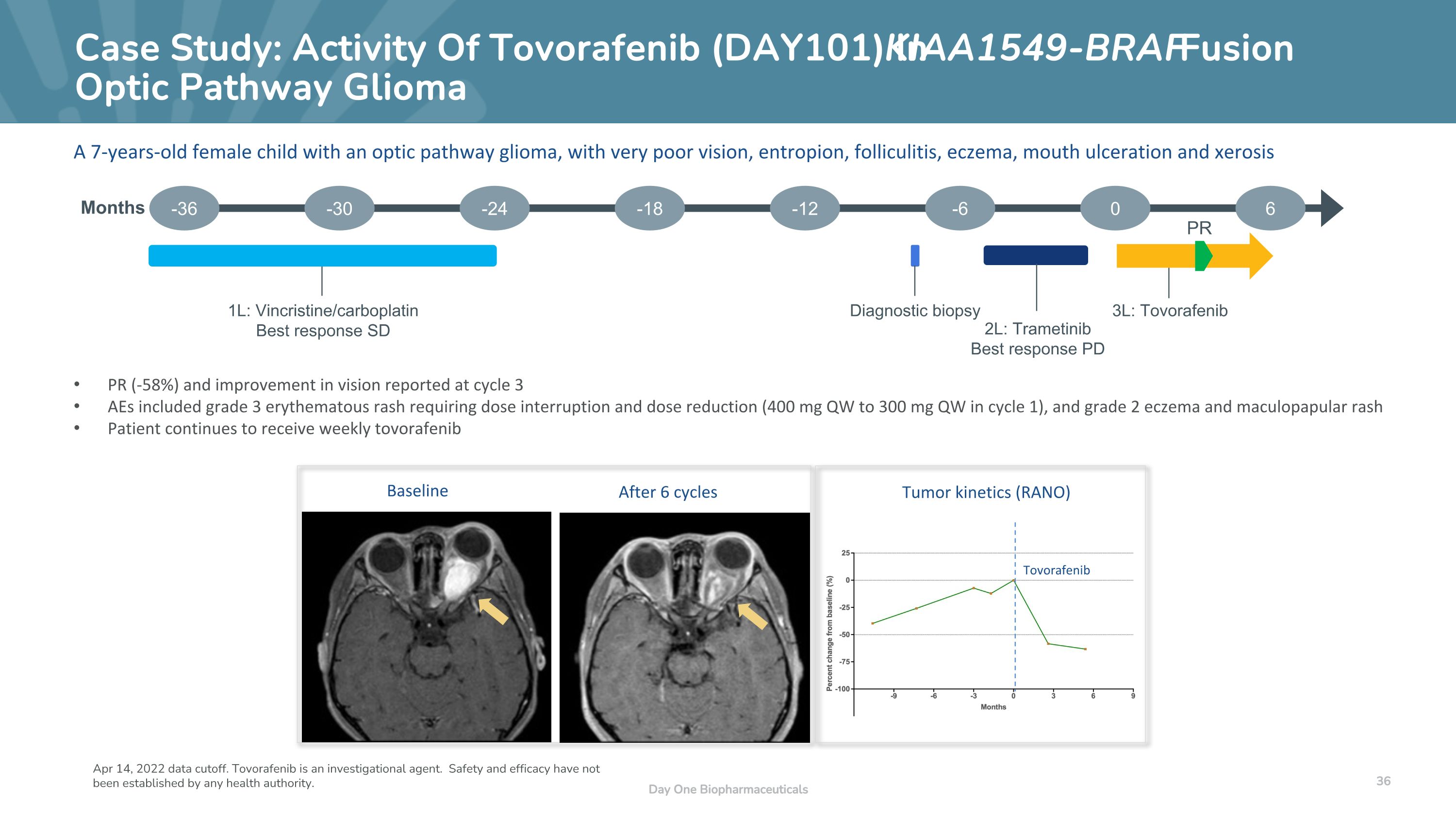
Case Study: Activity Of Tovorafenib (DAY101) In KIAA1549-BRAF Fusion Optic Pathway Glioma Day One Biopharmaceuticals Apr 14, 2022 data cutoff. Tovorafenib is an investigational agent. Safety and efficacy have not been established by any health authority. PR (-58%) and improvement in vision reported at cycle 3 AEs included grade 3 erythematous rash requiring dose interruption and dose reduction (400 mg QW to 300 mg QW in cycle 1), and grade 2 eczema and maculopapular rash Patient continues to receive weekly tovorafenib PR 1L: Vincristine/carboplatin Best response SD Months -36 -24 -18 -12 -6 0 6 -30 Diagnostic biopsy 2L: Trametinib Best response PD 3L: Tovorafenib A 7-years-old female child with an optic pathway glioma, with very poor vision, entropion, folliculitis, eczema, mouth ulceration and xerosis Baseline After 6 cycles Tumor kinetics (RANO) Tovorafenib
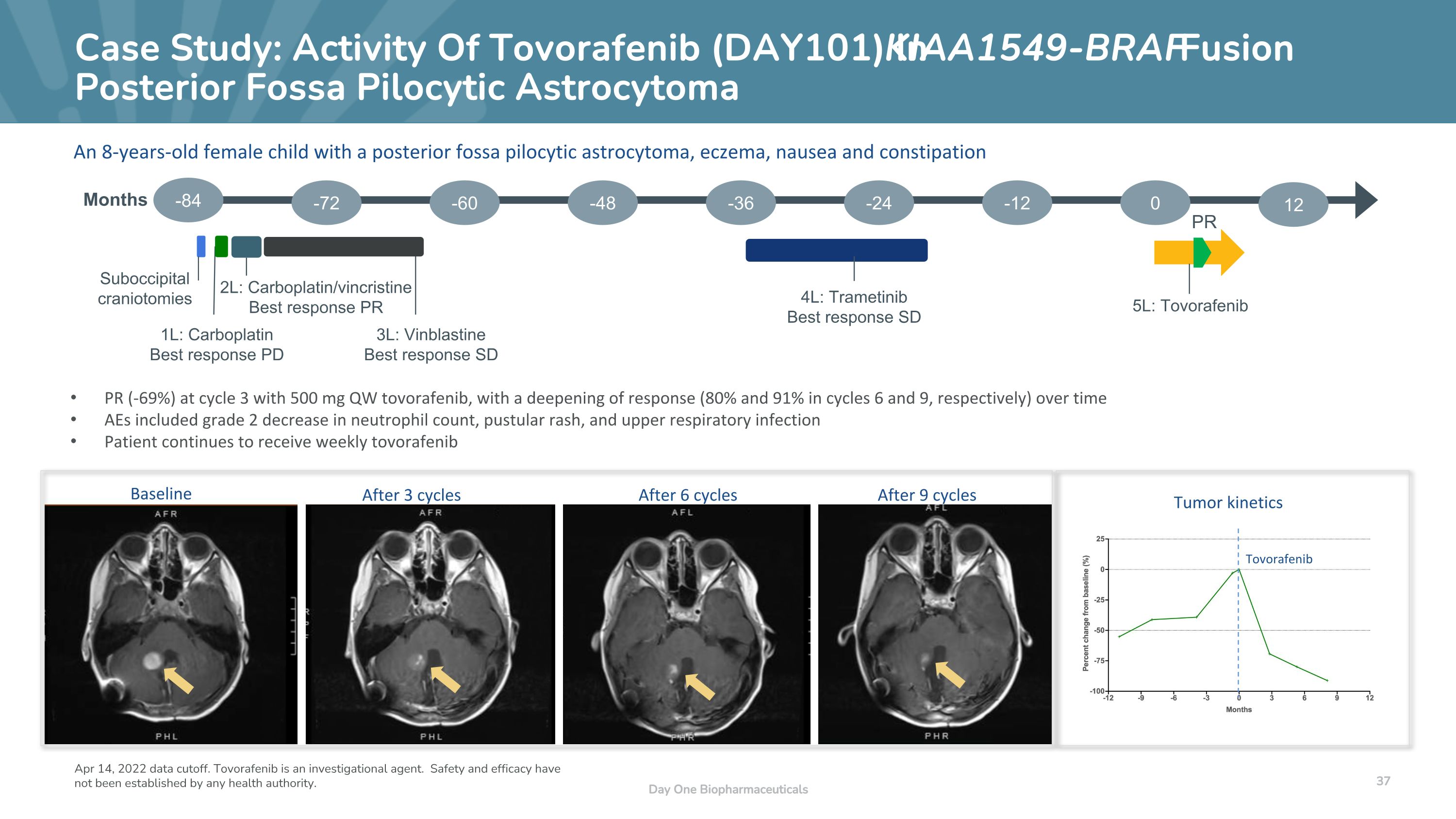
Case Study: Activity Of Tovorafenib (DAY101) In KIAA1549-BRAF Fusion Posterior Fossa Pilocytic Astrocytoma Day One Biopharmaceuticals Apr 14, 2022 data cutoff. Tovorafenib is an investigational agent. Safety and efficacy have not been established by any health authority. Baseline After 6 cycles After 3 cycles After 9 cycles Tumor kinetics PR (-69%) at cycle 3 with 500 mg QW tovorafenib, with a deepening of response (80% and 91% in cycles 6 and 9, respectively) over time AEs included grade 2 decrease in neutrophil count, pustular rash, and upper respiratory infection Patient continues to receive weekly tovorafenib Suboccipital craniotomies 2L: Carboplatin/vincristine Best response PR PR 3L: Vinblastine Best response SD Months -84 -48 -36 -24 -12 0 12 -72 4L: Trametinib Best response SD 5L: Tovorafenib -60 1L: Carboplatin Best response PD An 8-years-old female child with a posterior fossa pilocytic astrocytoma, eczema, nausea and constipation Tovorafenib
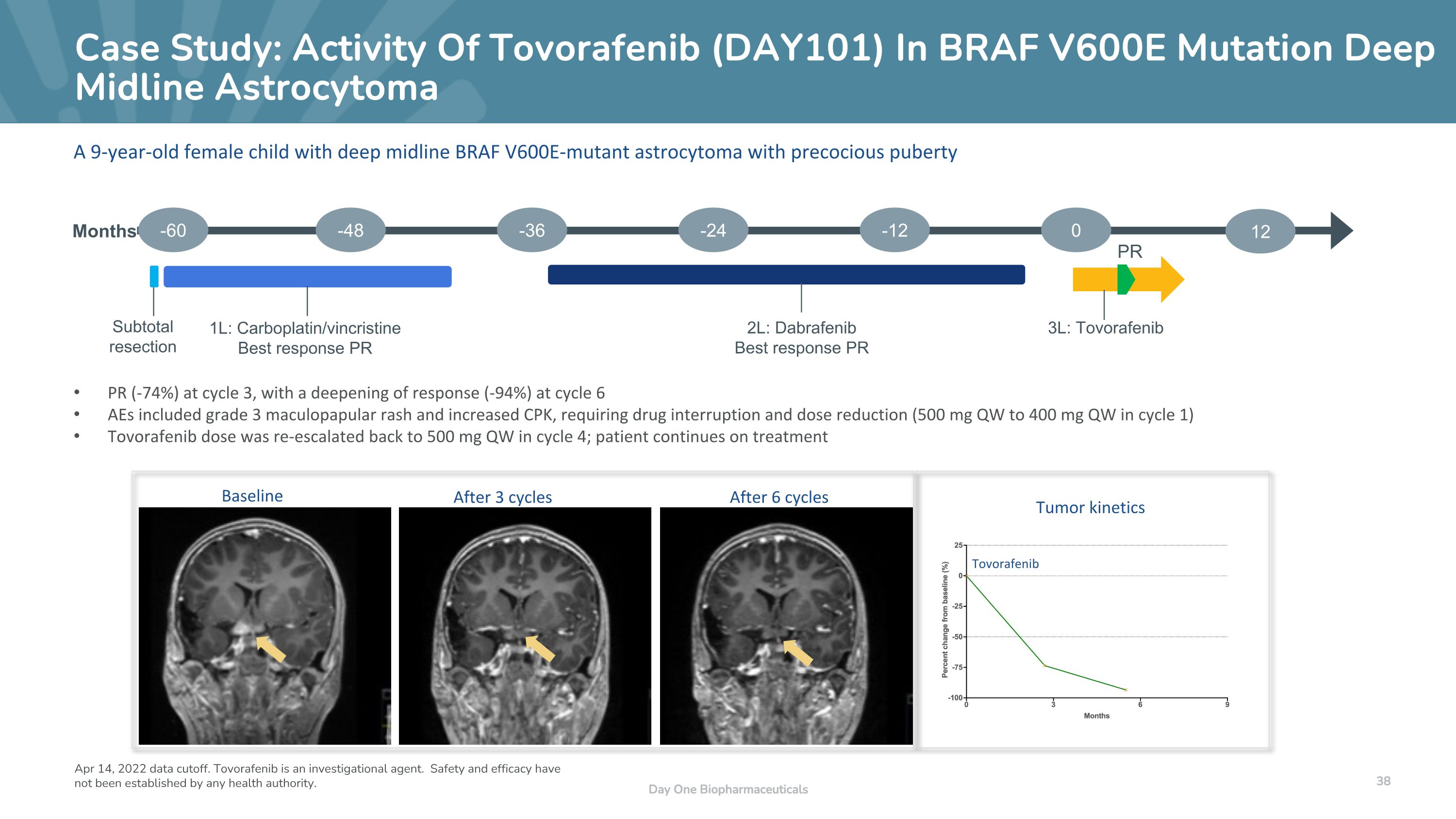
Case Study: Activity Of Tovorafenib (DAY101) In BRAF V600E Mutation Deep Midline Astrocytoma Day One Biopharmaceuticals Apr 14, 2022 data cutoff. Tovorafenib is an investigational agent. Safety and efficacy have not been established by any health authority. Baseline After 6 cycles After 3 cycles Tumor kinetics PR (-74%) at cycle 3, with a deepening of response (-94%) at cycle 6 AEs included grade 3 maculopapular rash and increased CPK, requiring drug interruption and dose reduction (500 mg QW to 400 mg QW in cycle 1) Tovorafenib dose was re-escalated back to 500 mg QW in cycle 4; patient continues on treatment PR Months -48 -36 -24 -12 0 12 -60 2L: Dabrafenib Best response PR 3L: Tovorafenib 1L: Carboplatin/vincristine Best response PR Subtotal resection A 9-year-old female child with deep midline BRAF V600E-mutant astrocytoma with precocious puberty Tovorafenib
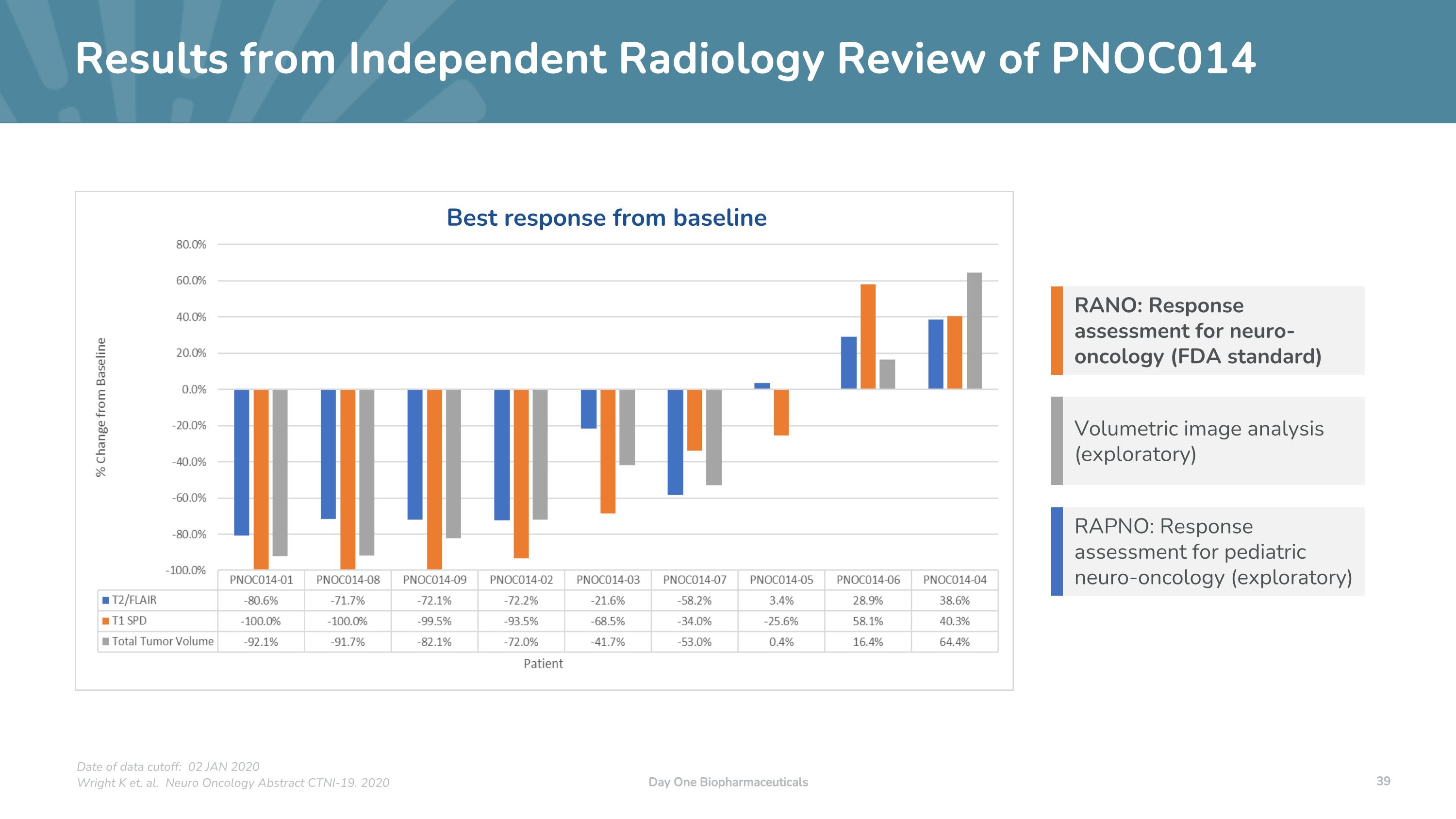
Results from Independent Radiology Review of PNOC014 Day One Biopharmaceuticals RAPNO: Response assessment for pediatric neuro-oncology (exploratory) RANO: Response assessment for neuro-oncology (FDA standard) Volumetric image analysis (exploratory) Best response from baseline Date of data cutoff: 02 JAN 2020 Wright K et. al. Neuro Oncology Abstract CTNI-19. 2020
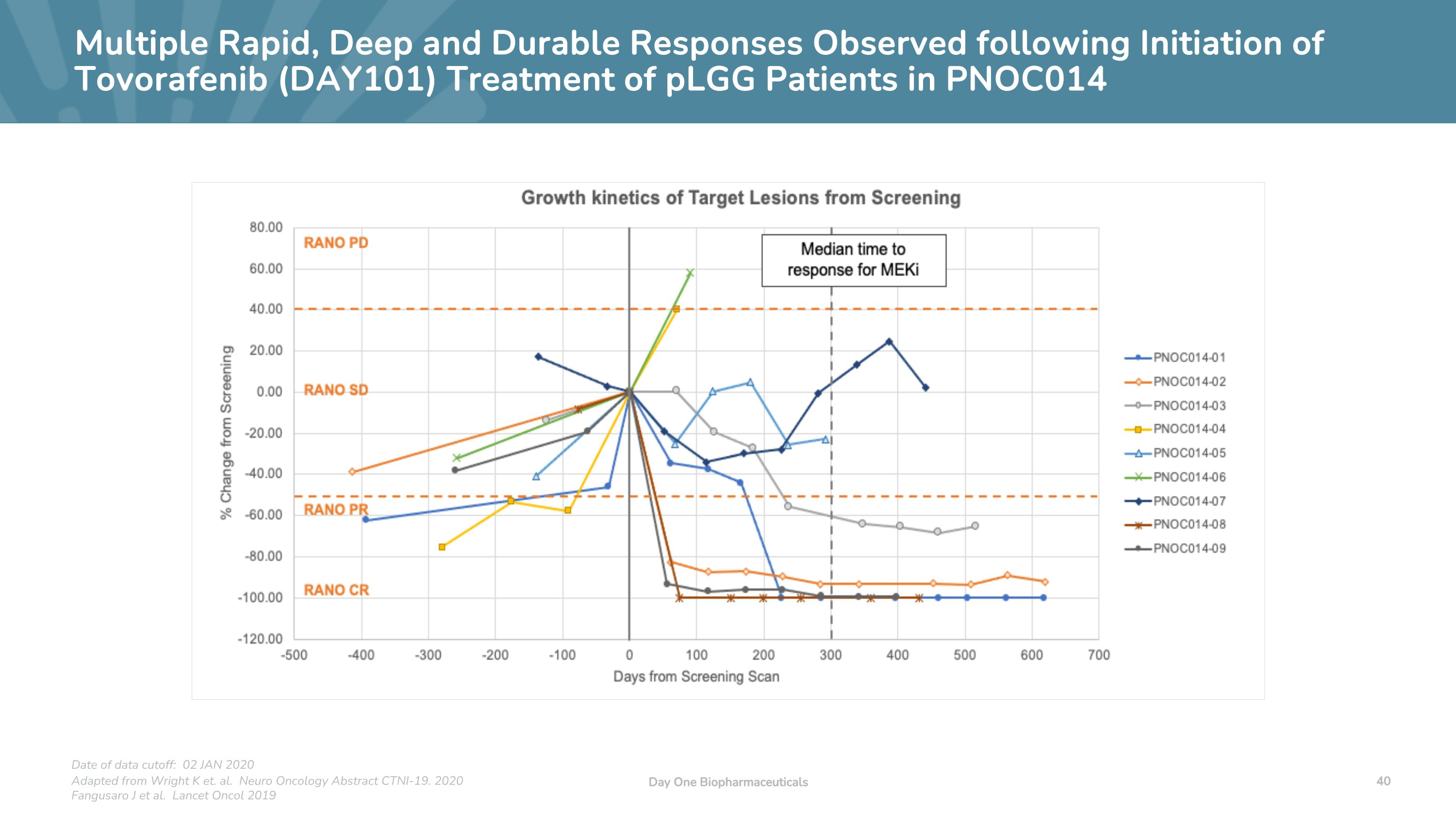
Multiple Rapid, Deep and Durable Responses Observed following Initiation of Tovorafenib (DAY101) Treatment of pLGG Patients in PNOC014 Day One Biopharmaceuticals Date of data cutoff: 02 JAN 2020 Adapted from Wright K et. al. Neuro Oncology Abstract CTNI-19. 2020�Fangusaro J et al. Lancet Oncol 2019
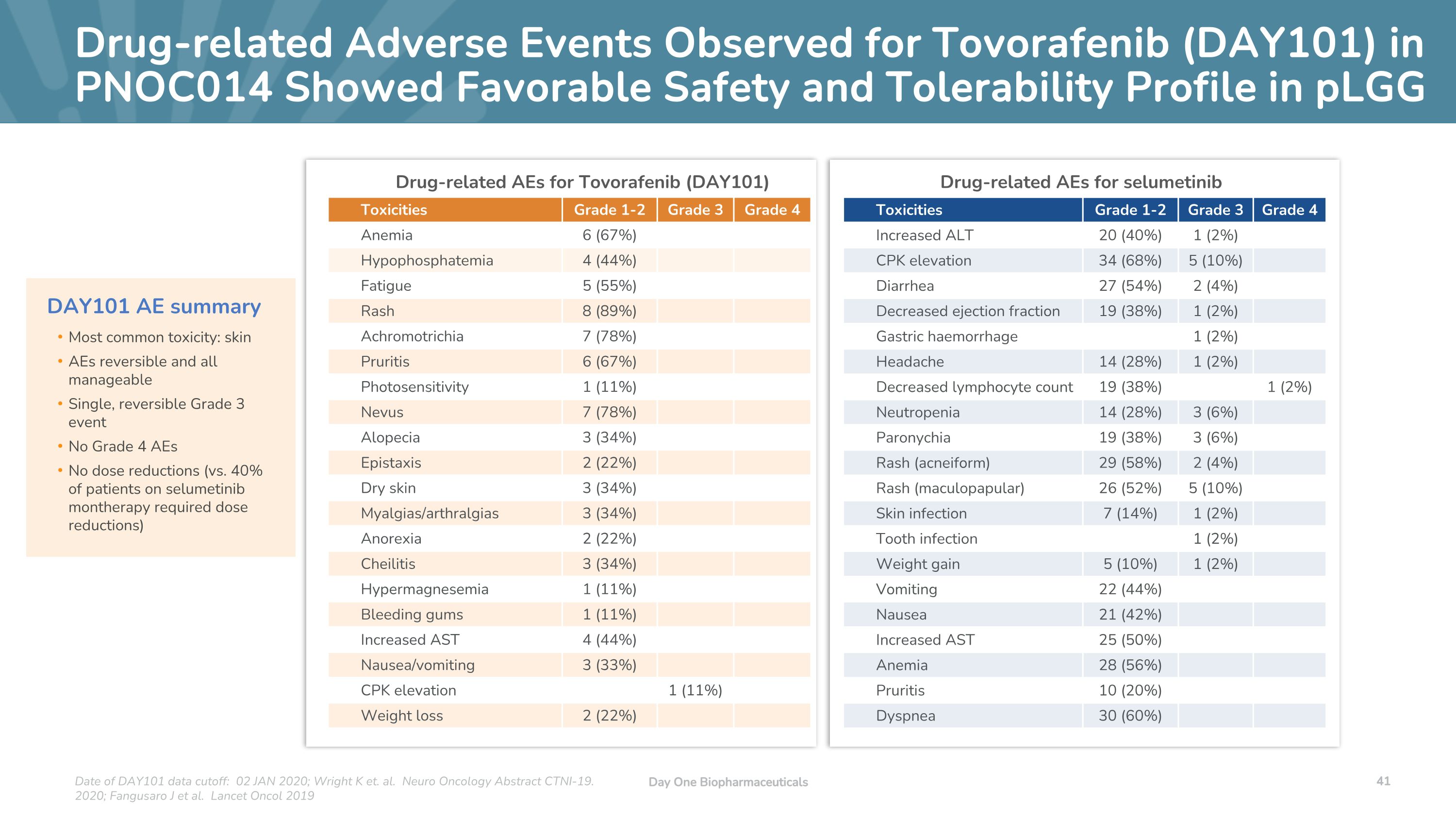
Drug-related Adverse Events Observed for Tovorafenib (DAY101) in PNOC014 Showed Favorable Safety and Tolerability Profile in pLGG Day One Biopharmaceuticals Date of DAY101 data cutoff: 02 JAN 2020; Wright K et. al. Neuro Oncology Abstract CTNI-19. 2020; Fangusaro J et al. Lancet Oncol 2019 Toxicities Grade 1-2 Grade 3 Grade 4 Anemia 6 (67%) Hypophosphatemia 4 (44%) Fatigue 5 (55%) Rash 8 (89%) Achromotrichia 7 (78%) Pruritis 6 (67%) Photosensitivity 1 (11%) Nevus 7 (78%) Alopecia 3 (34%) Epistaxis 2 (22%) Dry skin 3 (34%) Myalgias/arthralgias 3 (34%) Anorexia 2 (22%) Cheilitis 3 (34%) Hypermagnesemia 1 (11%) Bleeding gums 1 (11%) Increased AST 4 (44%) Nausea/vomiting 3 (33%) CPK elevation 1 (11%) Weight loss 2 (22%) DAY101 AE summary Most common toxicity: skin AEs reversible and all manageable Single, reversible Grade 3 event No Grade 4 AEs No dose reductions (vs. 40% of patients on selumetinib montherapy required dose reductions) Drug-related AEs for Tovorafenib (DAY101) Toxicities Grade 1-2 Grade 3 Grade 4 Increased ALT 20 (40%) 1 (2%) CPK elevation 34 (68%) 5 (10%) Diarrhea 27 (54%) 2 (4%) Decreased ejection fraction 19 (38%) 1 (2%) Gastric haemorrhage 1 (2%) Headache 14 (28%) 1 (2%) Decreased lymphocyte count 19 (38%) 1 (2%) Neutropenia 14 (28%) 3 (6%) Paronychia 19 (38%) 3 (6%) Rash (acneiform) 29 (58%) 2 (4%) Rash (maculopapular) 26 (52%) 5 (10%) Skin infection 7 (14%) 1 (2%) Tooth infection 1 (2%) Weight gain 5 (10%) 1 (2%) Vomiting 22 (44%) Nausea 21 (42%) Increased AST 25 (50%) Anemia 28 (56%) Pruritis 10 (20%) Dyspnea 30 (60%) Drug-related AEs for selumetinib








































